Golang interview questions and answers in 2025
If you want to work as a successful Golang developer for a top Silicon Valley firm or build a team of talented Golang developers, you've come to the right spot. We've carefully compiled a list of Golang developer interview questions for your Golang interview to give you an idea of the kind of Golang interview questions you can ask or be asked.

Publicly released in 2012, Go (Golang) is a statically typed, compiled programming language designed by Robert Griesemer, Rob Pike, and Ken Thompson at Google. Known for its simplicity, efficiency, and strong support for concurrent programming, it enables developers to build robust, high-performing applications.
If you aspire to become a successful Go developer at a top Silicon Valley company, or if you're planning to assemble a team of skilled Golang developers, you've come to the right place. We've curated a list of Golang interview questions to help you prepare for Golang developer jobs or help you find the right Go candidate.
Table of contents
Basic Golang interview questions and answers (33)Intermediate Golang interview questions and answers (35)Advanced Golang interview questions and answers (40)Basic Golang interview questions and answers
1.
What is Go programming language, and why is it used?
Go is a modern programming language developed by Google. It is designed to be simple, efficient, and reliable. It is often used for building scalable and highly concurrent applications. It combines the ease of use of a high-level language with the performance of a low-level language. Go's syntax is easy to understand and its standard library provides a wide range of functionalities.
Additionally, Go has built-in support for concurrency, making it ideal for developing applications that require dealing with multiple tasks simultaneously. Overall, Go is used for developing fast, efficient, and robust software, especially in the field of web development and cloud computing.
2.
How do you implement concurrency in Go?
In Go, concurrency is implemented using goroutines and channels. Goroutines are lightweight threads that can be created with the go keyword. They allow concurrent execution of functions.
Channels, on the other hand, are used for communication and synchronization between goroutines. They can be created using make and can be used to send and receive values.
To start a goroutine, simply prefix a function call with the go keyword. This will create a new goroutine that executes the function concurrently. Channels can be used to share data between goroutines, allowing them to communicate and synchronize.
By using goroutines and channels, Go provides a simple and efficient way to implement concurrency in programs.
3.
How do you handle errors in Go?
In Go, errors are handled using the error type. When a function encounters an error, it can return an error value indicating the problem. The calling code can then check if the error is nil. If not, it handles the error appropriately.
Go provides a built-in panic function to handle exceptional situations. When a panic occurs, it stops the execution of the program and starts unwinding the stack, executing deferred functions along the way. To recover from a panic, you can use the recover function in a deferred function. This allows you to handle the panic gracefully and continue the program execution.
4.
How do you implement interfaces in Go?
Interfaces are implemented implicitly in Go. This means that you don't need to explicitly declare that a type implements an interface. Instead, if a type satisfies all the methods defined in an interface, it is considered to implement that interface.
This is done by first defining the interface type using the type keyword followed by the interface name and the methods it should contain. The next step is creating a struct type or any existing type that has all the methods required by the interface. Go compiler will automatically recognize that type as implementing the interface.
Using interfaces can help you achieve greater flexibility and polymorphism in Go programs.
5.
How do you optimize the performance of Go code?
These strategies can optimize Go code performance:
- Minimize memory allocations: Avoid unnecessary allocations by reusing existing objects or using buffers.
- Use goroutines and channels efficiently: Leverage the power of concurrent programming, but ensure proper synchronization to avoid race conditions.
- Optimize loops and conditionals: Reduce the number of iterations by simplifying logic or using more efficient algorithms.
- Profile your code: Use Go's built-in profiling tools to identify bottlenecks and hotspots in your code.
6.
What is the role of the "init" function in Go?
The "init" function is a special function in Go that is used to initialize global variables or perform any other setup tasks needed by a package before it is used. The init function is called automatically when the package is first initialized. Its execution order within a package is not guaranteed.
Multiple init functions can be defined within a single package and even within a single file. This allows for modular and flexible initialization of package-level resources. Overall, the init function plays a crucial role in ensuring that packages are correctly initialized and ready to use when they are called.
7.
What are dynamic and static types of declaration of a variable in Go?
The compiler must interpret the type of variable in a dynamic type variable declaration based on the value provided to it. The compiler does not consider it necessary for a variable to be typed statically.
Static type variable declaration assures the compiler that there is only one variable with the provided type and name, allowing the compiler to continue compiling without having all of the variable's details. A variable declaration only has meaning when the program is being compiled; the compiler requires genuine variable declaration when the program is being linked.
8.
What is the syntax for declaring a variable in Go?
In Go, variables can be declared using the var keyword followed by the variable name, type, and optional initial value. For example:
var age int = 29
Go also allows short variable declaration using the := operator, which automatically infers the variable type based on the assigned value. For example:
age := 29
In this case, the type of the variable is inferred from the value assigned to it.
9.
What are Golang packages?
This is a common Golang interview question. Go Packages (abbreviated pkg) are simply directories in the Go workspace that contain Go source files or other Go packages. Every piece of code created in the source files, from variables to functions, is then placed in a linked package. Every source file should be associated with a package.
10.
What are the different types of data types in Go?
The various data types in Go are:
- Numeric types: Integers, floating-point, and complex numbers.
- Boolean types: Represents true or false values.
- String types: Represents a sequence of characters.
- Array types: Stores a fixed-size sequence of elements of the same type.
- Slice types: Serves as a flexible and dynamic array.
- Struct types: Defines a collection of fields, each with a name and a type.
- Pointer types: Holds the memory address of a value.
- Function types: Represents a function.
11.
How do you create a constant in Go?
To create a constant in Go, you can use the const keyword, followed by the name of the constant and its value. The value must be a compile-time constant such as a string, number, or boolean. Here's an example:
const Pi = 3.14159
After defining a constant, you can use it in your code throughout the program. Note that constants cannot be reassigned or modified during the execution of the program.
Creating constants allows you to give meaningful names to important values that remain constant throughout your Go program.
12.
What data types does Golang use?
This is a common golang interview question. Golang uses the following types:
- Slice
- Struct
- Pointer
- Function
- Method
- Boolean
- Numeric
- String
- Array
- Interface
- Map
- Channel
13.
Distinguish unbuffered from buffered channels.
This is a popular Golang interview question. The sender will block on an unbuffered channel until the receiver receives data from the channel, and the receiver will block on the channel until the sender puts data into the channel.
The sender of the buffered channel will block when there is no empty slot on the channel, however, the receiver will block on the channel when it is empty, as opposed to the unbuffered equivalent.
14.
Explain string literals.
A string literal is a character-concatenated string constant. Raw string literals and interpreted string literals are the two types of string literals. Raw string literals are enclosed in backticks (foo) and contain uninterpreted UTF-8 characters. Interpreted string literals are strings that are written within double quotes and can contain any character except newlines and unfinished double-quotes.
15.
What is a Goroutine and how do you stop it?
A Goroutine is a function or procedure that runs concurrently with other Goroutines on a dedicated Goroutine thread. Goroutine threads are lighter than ordinary threads, and most Golang programs use thousands of goroutines at the same time.
A Goroutine can be stopped by passing it a signal channel. Because Goroutines can only respond to signals if they are taught to check, you must put checks at logical places, such as at the top of your for a loop.
16.
What is the syntax for creating a function in Go?
To create a function in Go, you need to use the keyword func, followed by the function name, any parameter(s) enclosed in parentheses, and any return type(s) enclosed in parentheses. The function body is enclosed in curly braces {}.
Here is an example function that takes two integers as input and returns their sum:

We declare a function called add that takes two parameters, x and y, and returns their sum as an int.
17.
How do you create a loop in Go?
The most commonly used loop is the for loop. It has three components: the initialization statement, the condition statement, and the post statement.
Here is an example of a for loop:

In this example, the loop will iterate 10 times. You can modify the i, condition, and post statement to customize the loop behavior.
18.
What is the syntax for an if statement in Go?
The syntax for an if statement in Go is straightforward and similar to other programming languages. The if keyword is followed by a condition enclosed in parentheses, and the body of the statement is enclosed in curly braces.
For example,

This code block compares variables a and b and prints a message depending on their values. The condition is evaluated, and if it's true, the code inside the curly braces is executed. If it's false, the program skips to the else statement.
19.
What are some benefits of using Go?
This is an important Golang interview question. Go is an attempt to create a new, concurrent, garbage-collected language with quick compilation and the following advantages:
- On a single machine, a big Go application can be compiled in a matter of seconds.
- Go provides an architecture for software development that simplifies dependency analysis while avoiding much of the complexity associated with C-style programs, such as files and libraries.
- Because there is no hierarchy in Go's type system, no work is wasted describing the relationships between types. Furthermore, while Go uses static types, the language strives to make types feel lighter weight than in traditional OO languages.
- Go is fully garbage-collected and supports parallel execution and communication at a fundamental level.
- Go's design presents a method for developing system software on multicore processors.
20.
How do you create a pointer in Go?
You can use the & symbol, followed by a variable to create a pointer in Go. This returns the memory address of the variable. For example, if you have a variable num of type int, you can create a pointer to num like this:
var num int = 42
var ptr *int = &num
Here, ptr is a pointer to num. You can use the * symbol to access the value stored in the memory address pointed by a pointer. For instance, *ptr will give you the value 42. Pointers are useful for efficient memory sharing and passing references between functions.
21.
What is the syntax for creating a struct in Go?
You need to define a blueprint for the struct, which may consist of fields of different data types. The blueprint for the struct is defined using the 'type' keyword, followed by the name you want to give the struct.
You then use the 'struct' keyword, followed by braces ('{}') where you list the fields, each with a name and a data type separated by a comma.
For instance, the syntax for creating a struct named Person with the fields name, age, and job of string, integer, and string data types, respectively, would be:

22.
How do you create an array in Go?
Creating an array in Go is simple. First, you need to declare the array by specifying its type and size. You can do this by using the following syntax:
var myArray [size]datatype
Replace size and datatype with the size and data type you want to use for your array. After declaring the array, you can then initialize it by assigning values to each index. You can also access and modify elements of the array using their index number.
Arrays in Go have fixed sizes, meaning you cannot add or remove elements once they are declared.
23.
How will you perform inheritance with Golang?
This is a trick golang interview question because Golang does not support classes, hence there is no inheritance.
However, you may use composition to imitate inheritance behavior by leveraging an existing struct object to establish the initial behavior of a new object. Once the new object is created, the functionality of the original struct can be enhanced.
24.
How do you create a slice in Go?
You first need to define a variable of type slice using the make() function. The make() function takes two arguments: the first is the type of the slice you want to create (for example, []string for a slice of strings) and the second is the length of the slice. The length of the slice is not fixed and can be changed dynamically as elements are added or removed.
Here’s an example to create a slice of strings with a length of 5:
mySlice := make([]string, 5)
You can access and modify the elements in the slice using their index.
25.
What is the difference between an array and a slice in Go?
In Go, an array is a fixed-length sequence of elements of the same type. Once an array is defined, the length cannot be changed. On the other hand, a slice is a dynamically-sized, flexible view of an underlying array. It is created with a variable length and can be resized.
Slices are typically used when you need to work with a portion of an array or when you want to pass a subset of an array to a function. Slices provide more flexibility and are widely used in Go for their convenience and efficiency in managing collections of data.
26.
How do you create a map in Go?
You can use the make keyword, followed by the map keyword and the data types for the key and value. The syntax would be make(map[keyType]valueType).
For example, to create a map of string keys and integer values, you would use make(map[string]int). You can assign values to the map using the bracket notation such as mapName[key] = value. To access values, simply use mapName[key].
Remember, maps in Go are unordered collections of key-value pairs, making them useful for storing and retrieving data efficiently.
27.
How do you iterate through a map in Go?
To iterate through a map in Go, you can use a for loop combined with the range keyword. For example:

In this loop, key represents the key of each key-value pair in the map, and value represents the corresponding value. You can perform any desired operation within the loop. The range keyword automatically iterates over the map and gives you access to its keys and values.
28.
What is a goroutine in Go?
A goroutine is a lightweight thread of execution that enables concurrent programming. It is a function that can be run concurrently with other goroutines. It is managed by the Go runtime and has a very small footprint compared to threads in other programming languages.
Goroutines are more efficient in terms of memory usage and can be created and destroyed quickly. They can communicate with each other through channels, which provide a safe way to exchange data and synchronize their execution. This allows for efficient and scalable concurrent programming in Go.
29.
What are the looping constructs in Go?
There is only one looping construct in Go: the for loop. The for loop is made up of three parts that are separated by semicolons:
- Before the loop begins, the Init statement is run. It is frequently a variable declaration that is only accessible within the scope of the for a loop.
- Before each iteration, the condition statement is evaluated as a Boolean to determine if the loop should continue.
- At the end of each cycle, the post statement is executed.
30.
What is a channel in Go?
In Go, a channel is a data structure that allows goroutines (concurrent functions) to communicate and synchronize with each other. It can be thought of as a conduit through which you can pass values between goroutines. A channel has a specific type that indicates the type of values that can be sent and received on it.
Channels can be used to implement synchronization between goroutines and data sharing. They provide a safe and efficient way to coordinate the flow of information, ensuring that goroutines can send and receive data in a controlled and synchronized manner.
31.
How do you create a channel in Go?
You can use the built-in make function with the chan keyword to create a channel in Go. Here's an example:
ch := make(chan int)
In the above code, a channel called ch has been created that can transmit integers. This channel can be used to send and receive data between goroutines.
By default, channels are unbuffered, meaning that the sender blocks until the receiver is ready. You can also create buffered channels by providing a buffer capacity as a second argument to the make function.
Channels are a powerful synchronization mechanism in Go, allowing safe communication and coordination between concurrent processes.
32.
How do you close a channel in Go?
The close() function is used to close a channel in Go. The function is used to indicate that no more values will be sent through the channel. Once a channel is closed, any subsequent attempt to send data through it will result in a runtime panic. However, receiving from a closed channel is still possible.
With the built-in v, ok := <-ch syntax, you can receive values from a closed channel. The ok boolean flag will be set to false if the channel is closed. It's important to note that closed channels should only be used for signaling and not for synchronization.
33.
How do you range over a channel in Go?
To range over a channel in Go, a for loop with the range keyword can be used. This allows you to iterate over all the values sent on the channel until it is closed. When using range, the loop will continue until the channel is closed or until no more values are available.
Here is an example of how to range over a channel in Go:

The loop will print the values 0 to 4 as they are sent on the channel.
Tired of interviewing candidates to find the best developers?
Hire top vetted developers within 4 days.
Intermediate Golang interview questions and answers
1.
How do you handle panics and recover from them in Go?
To handle panics and recover from them in Go, the built-in panic() and recover() functions can be used. When an error occurs, panic() is called and the program execution stops. You can use the defer statement to call recover(), which stops the panic and resumes execution from the point of the nearest enclosing function call, after all deferred functions have been run.
It's important to note that you should only use panic and recover for exceptional cases such as when a program encounters unexpected errors. It's not meant to handle normal control flow or act as a replacement for checking errors.
Using these functions properly can help you ensure programs remain robust and reliable.
2.
Explain the defer statement in Golang. Give an example of a deferred function’s call.
The defer statement in Golang is used to postpone the execution of a function until the surrounding function completes. It is often used when you want to make sure some cleanup tasks are performed before exiting a function, regardless of errors or other conditions.
Here's an example of a deferred function's call:
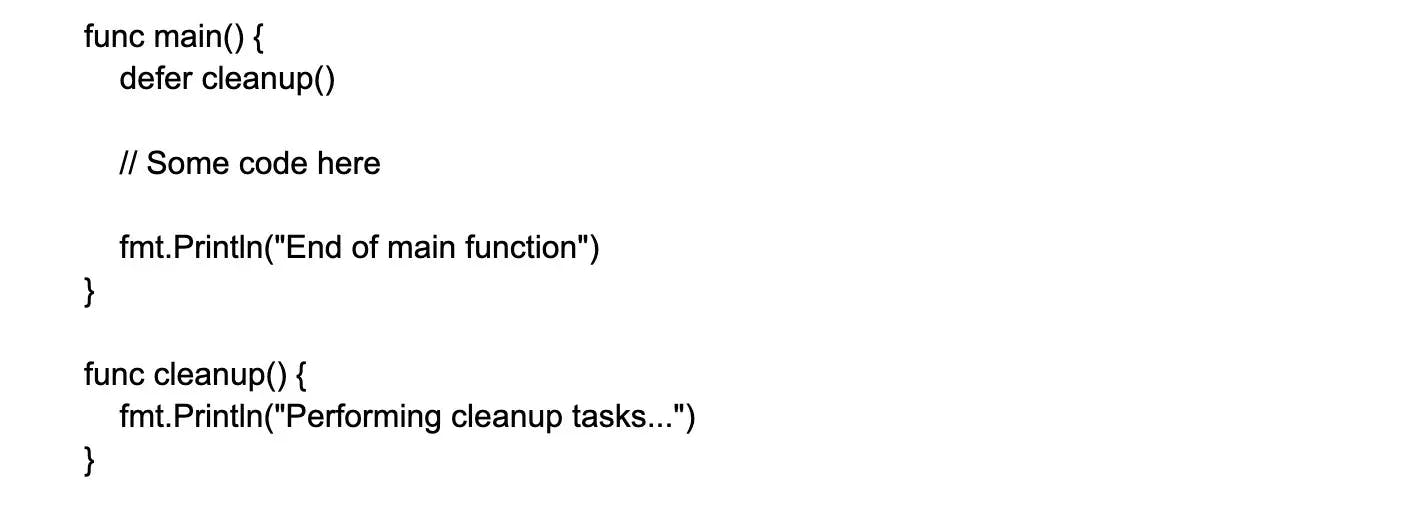
The cleanup function will be executed right before the main function exits, ensuring that cleanup tasks are always performed.
3.
How do you create and use a package in Go?
- Create a directory for your package. Use a meaningful name that represents the package's functionality.
- Inside the directory, create a Go source file. The name of the file should match the directory name.
- Add code to the source file, defining functions, variables, and types that make up your package.
- At the top of your source file, add a package statement with the name of your package.
- To use the package in another Go program, import it by using the package name, followed by the directory path.
4.
What is the difference between a package and a module in Go?
In Go, a package is a collection of related Go source files that can be compiled together. It acts as a unit of distribution and code organization. It provides a way to reuse code across different projects and allows for encapsulation of functionality.
On the other hand, a module in Go is a collection of packages that are versioned together. It allows for managing dependencies and provides a way to ensure that the correct versions of packages are used in a project. It also facilitates versioning and dependency management.
In short, a package is a unit of code organization, while a module is a unit of versioning and dependency management in Go.
5.
How do you create a custom type in Go?
Custom types are useful for improving code readability and creating abstractions. To create a custom type in Go, you can use the type keyword, followed by the name of your type and the underlying type it should be based on.
For example, if you want to create a custom type called Person based on the string type, you would use type Person string. You can also create a custom type based on a struct or any other built-in type in Go. Once your custom type is defined, you can use it like any other data type in your code.
6.
What is the syntax for type casting in Go?
In Go, type casting is done using the Type(value) syntax. To convert a value to a specific type, you need to mention the desired type in parentheses, followed by the value you want to convert.
For example, if you want to convert an integer to a floating-point number, you can use the syntax float64(42). Similarly, if you want to convert a floating-point number to an integer, you can use the syntax int(3.14).
Keep in mind that type casting should be used carefully as it can result in data loss or unexpected behavior if done incorrectly.
7.
How do you use the "blank identifier" in Go?
The blank identifier, represented by an underscore character, is used in Go as a placeholder for a variable or value that is not needed or used in code. It allows programmers to ignore an unused variable without generating a compiler warning.
If a function returns multiple values but only one of them needs to be used, you can use the blank identifier to discard the others. Additionally, it can be used in variable declarations to indicate that the variable is not needed for the code to compile.
Overall, the blank identifier is a helpful tool for reducing clutter in code when you don't need to use certain variables or values.
8.
How do you create and use a pointer to a struct in Go?
To create and use a pointer to a struct in Go, define the struct type using the type keyword. Then, you declare a pointer variable by using an asterisk * before the struct type name.
For example, to create a pointer to a struct named Person, define the struct type as type Person struct { /* struct fields */ }, and then declare a pointer variable p using var p *Person.
To access the fields of the struct through the pointer, use the arrow “.” syntax. For example, to access the name field of the p pointer, use p.name.
9.
How do you embed a struct in Go?
To embed a struct in Go, you only have to declare a field in a struct and assign it the value of another struct. This field with a struct value is then known as an embedded struct.
You can also access the embedded struct's fields by using dot notation with the parent struct. This allows you to reuse the fields and methods of the embedded struct without explicitly declaring them in the parent struct.
Additionally, you can use anonymous fields to embed a struct without specifying a name for the field. This helps to simplify the code and make it more concise.
10.
How do you create and use a function closure in Go?
Closures are useful for creating private variables and to bind values to callback functions.
To create a function closure in Go, first define a function containing the variables you want to access and return it. Then, assign the function to a variable. This will create a closure where the variables within the function are accessible to the assigned variable and any functions returned by it.
To use the closure, call the assigned variable, which will execute the contained function. The inner variables will retain their values between function calls.
11.
What is the syntax for creating and using a function literal in Go?
In Go, a function literal is created using the "func" keyword, followed by the formal parameters within parentheses, and the function body enclosed within curly braces. The syntax looks like this:
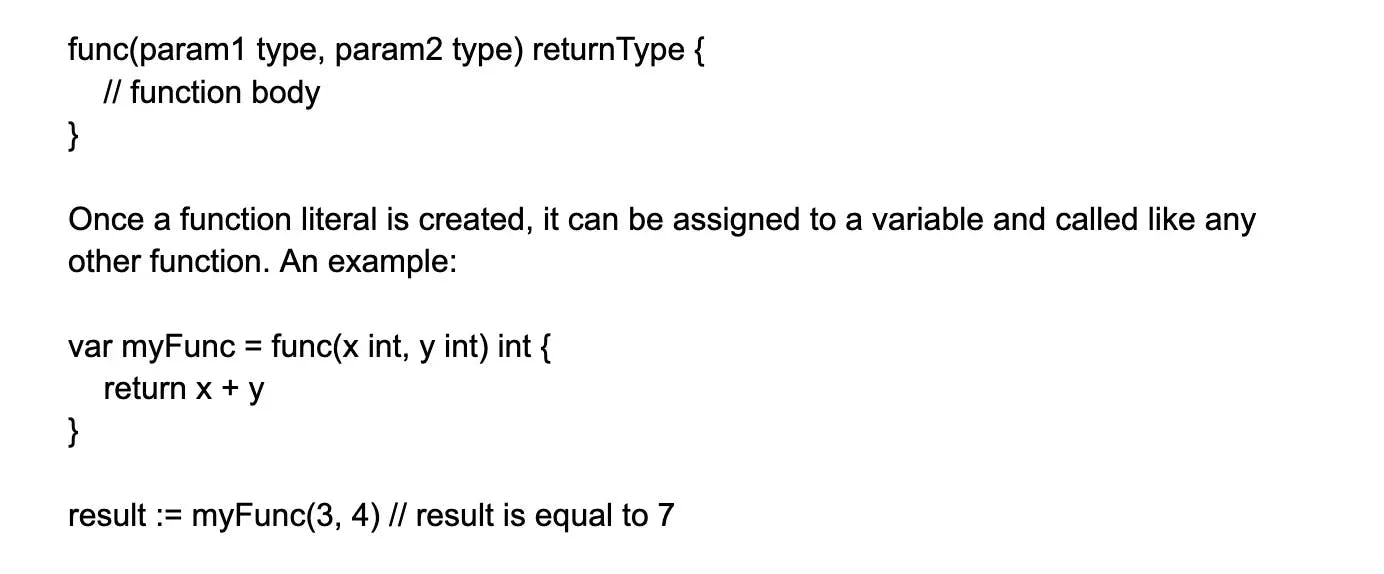
Function literals can also be passed as arguments to other functions or returned as values from functions, making them a powerful feature of Go's functional programming capabilities.
12.
How do you use the "select" statement in Go?
The "select" statement in Go is used for multiplexing channels, allowing a Go program to handle multiple channels at once. With "select," you can send and receive data from multiple channels which allows for efficient communication between goroutines.
The basic syntax of "select" allows you to specify multiple channels and assign their input and output to different cases. It can also be used with the default case that executes if no other case is ready.
The "select" statement allows for powerful concurrent programming in Go and facilitates easier and more efficient communication between independently executing goroutines.
13.
What is the syntax for creating and using a type assertion in Go?
In Go, a type assertion is used to extract a value of an underlying concrete type from an interface value. The syntax for creating and using a type assertion involves putting the keyword .(type) after the value that you want to assert the type of.
Here's an example:

In this example, val is asserted to be of type string. If successful, it is printed to the console. The second variable ok is used to determine if the assertion was successful or not.
14.
What is the syntax for creating and using a type switch in Go?
In Go, a type switch allows you to determine the type of an interface variable at runtime and perform different actions depending on its type. The syntax for a type switch involves the 'switch' keyword, followed by the variable name in parentheses with type assertion.
Each case within the 'switch' statement defines a type preceded by the 'case' keyword. The keyword 'default' can also be used to define an action for any non-matching type. Within each case, you can perform operations specific to the type of the variable.
The syntax for creating and using a type switch in Go is relatively straightforward and allows for efficient code optimization based on different types of input.
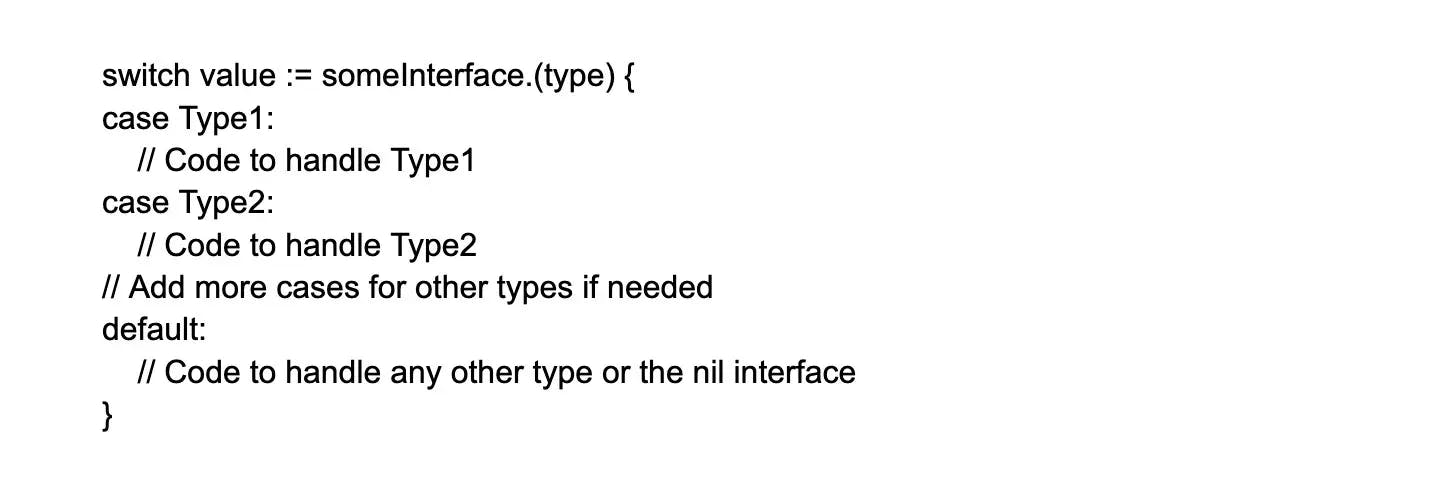
15.
What is the syntax for creating and using a type conversion in Go?
In Go, type conversion can be performed by specifying the desired type in parentheses, followed by the value or expression to be converted. The syntax for creating a type conversion is as follows:
var num float64 = 3.14
var intNum int = int(num)
In this example, there is a variable num of type float64 and we want to convert it to an int using type conversion. The intNum variable is assigned the value of num converted to an int. Type conversions can also be used within expressions to ensure that all operands are of the same type.
16.
How do you use the "sync" package to protect shared data in Go?
The "sync" package in Go provides a set of tools that can be used to protect shared data from being accessed concurrently by multiple goroutines. One of the most popular ways to protect shared data is by using a mutex.
A mutex is a synchronization object that can be used to protect a resource so that only one goroutine can access it at a time. To use a mutex, you create a new instance of the sync.Mutex struct, and then use the Lock and Unlock methods to protect the critical section of code.
By doing this, you ensure that no two goroutines can access the shared data at the same time, which helps prevent data races and other synchronization issues.
17.
How do you use the "sync/atomic" package to perform atomic operations in Go?
To use the "sync/atomic" package in Go, you need to import it into your code using the import statement. Once done, the package provides functions and types to perform atomic operations on variables.
To perform an atomic operation, define a variable of the desired type using one of the atomic types provided by the package (e.g., int32, int64). Then, use the atomic functions like atomic.LoadXXX and atomic.StoreXXX to atomically load and store values.
These atomic operations ensure that the operations on the variable are performed in an atomic manner, avoiding race conditions and guaranteeing data integrity.
18.
How do you use the "context" package to carry around request-scoped values in Go?
There are a few steps involved to use the "context" package in Go to carry around request-scoped values:
- Import the "context" package: import "context".
- Create a new context with the context.Background() function: ctx := context.Background().
- Add values to the context using the WithValue method: ctxWithValue := context.WithValue(ctx, key, value).
- To retrieve the value from the context, use the Value method: val := ctxWithValue.Value(key).
Remember that the key needs to be unique to your application to avoid conflicts with other packages.
By using the "context" package, you can pass request-scoped values throughout your Go application easily.
19.
How do you use the "net/http" package to build an HTTP server in Go?
To build an HTTP server in Go, you can use the built-in "net/http" package that provides a range of functions and methods to handle HTTP requests and responses.
To get started, define a handler function that takes in an HTTP response writer and request. Then, register the handler function with the "http" package that handles incoming requests and invokes the handler function.
With the "http" package, you can specify the port number, listen for incoming requests, and gracefully shut down the server. Overall, the "net/http" package offers a simple and effective way to quickly build HTTP servers in Go.
20.
How do you use the "encoding/json" package to parse and generate JSON in Go?
To use the "encoding/json" package in Go, you have two main functions at your disposal: "json.Marshal" and "json.Unmarshal".
You can use "json.Marshal" to generate JSON from a Go data structure. This function takes Go data and encodes it into a JSON string you can then use as needed.
Meanwhile, you can use "json.Unmarshal" to parse JSON and convert it into Go data. This function takes a JSON string and decodes it into a Go data structure.
Both of these functions require you to define struct tags on your Go data structure to specify how the JSON should be formatted.
These functions are the key to effectively working with JSON in Go using the "encoding/json" package.
21.
How do you use the "reflect" package to inspect the type and value of a variable in Go?
To use the "reflect" package in Go, import it using import "reflect". You can then inspect the type and value of a variable using the reflect.TypeOf() and reflect.ValueOf() functions, respectively.
For example, you can use reflect.TypeOf(x) to inspect the type of a variable x. This will return a reflect.Type object. Similarly, you can use reflect.ValueOf(x) to inspect the value of x. This will return a reflect.Value object.
The methods provided by these objects can be used to further inspect and manipulate the variable's type and value.
22.
How do you use the "testing" package to write unit tests in Go?
To write unit tests in Go using the "testing" package, you first need to create a test file with a name that ends in _test.go. In this file, write functions that start with Test, followed by the name of the function you want to test, for example, TestAddition(). Then, inside the test function, write assertions using the t parameter that represents the testing.T type.
You can call specific functions or subtests within a test file using the go test command, followed by the package name or file name. go test runs all tests in all files, while go test -run=TestAddition runs only the TestAddition test.
The testing package includes a variety of useful functions, such as Errorf() and Fatal(), to help you write better tests.
23.
How do you use the "errors" package to create and manipulate errors in Go?
Here are the steps to create and manipulate errors with the "errors" package:
- Import the "errors" package into your code: import "errors".
- Create a new error by using the errors.New() function and passing in a string describing the error: err := errors.New("Something went wrong").
- Manipulate the error by checking its value. You can compare the error with another error using the errors.Is() function or retrieve the error message by calling err.Error().
24.
How do you use the "net" package to implement networking protocols in Go?
The "net" package is a built-in Go library that provides basic networking functionality. It allows for communication over network protocols such as TCP, UDP, and Unix domain sockets.
To use this package, import it into your code and then create network connections using the functions provided by "net". For example, "net.Dial()" is used to establish a TCP connection to a server.
Other functions, such as "net.Listen()" and "net.Accept()", are used to create and accept incoming network connections. By utilizing the "net" package, you can easily implement networking protocols in Go programs with minimal effort.
25.
How do you use the "time" package to handle dates and times in Go?
To use the "time" package in Go, first import it with import "time". This package provides functions and types to handle dates and times.
A few useful methods to perform various operations:
- To get the current time, use time.Now().
- To format it, use the Format() method, specifying the desired layout or format string such as time.Now().Format("2006-01-02 15:04:05").
- To parse a string into a time value, use time.Parse() and provide the layout of the string. For example, time.Parse("2006-01-02", "2022-12-31") would parse the string "2022-12-31" into a time value.
You can perform other operations on time values, such as adding and subtracting durations using the Add() and Sub() methods, respectively.
Remember, the "time" package is very flexible and can handle various time-related tasks efficiently in Go.
26.
How do you use the "math" and "math/rand" packages to perform mathematical and statistical operations in Go?
The "math" and "math/rand" packages are built into Go and provide extensive mathematical and statistical operation functionalities. The "math" package, for instance, offers fundamental mathematical constants such as Pi, mathematical functions for trigonometry, exponential, and logarithmic, as well as rounding and floating-point operations.
The "math/rand" package is specially designed to generate random numbers based on pseudo-random number generator algorithms. This package can be used for statistical simulations or for generating random passwords and encryption keys.
To use these packages, import them into your Go program. You can then call various functions and methods provided by the packages for their specific purposes.
27.
How do you use the "crypto" package to perform cryptographic operations in Go?
The "crypto" package in Go provides a set of tools for performing cryptographic operations. To use it, you need to import the package using:
import "crypto"
You can then use the various functions provided by the package for cryptographic operations such as hashing, encryption, and decryption. For example, to generate a SHA-256 hash of a message, you can use the code:

This code will generate a SHA-256 hash of the message "Hello, world!" in hexadecimal format. The "crypto" package provides many other functions for performing different kinds of cryptographic operations.
28.
How do you use the "os" package to interact with the operating system in Go?
In Go, the "os" package provides a way to interact with the operating system. You can use the package to perform operations like creating, opening, reading, writing, and deleting files and directories, among other things.
To use the "os" package, you need to import it using the import statement, after which you can access its functions and types. Some of the common functions that you can use are os.Open(), os.Create(), os.ReadDir(), os.Mkdir(), and os.RemoveAll(), among others.
Such functions allow you to work with files and directories and modify file attributes and access the terminal's environment variables, among other interactions with the operating system.
29.
How do you use the "bufio" package to read and write buffered data in Go?
To use the bufio package in Go, you first need to import the package using the statement import "bufio". The bufio package provides buffered I/O operations for reading and writing data.
To read buffered data, create a new bufio.Reader object by passing an io.Reader object to the bufio.NewReader() function. You can then use methods like ReadString(), ReadBytes(), or ReadLine() to read the data.
To write buffered data, create a new bufio.Writer object by passing an io.Writer object to the bufio.NewWriter() function. You can then use methods like WriteString(), Write(), or Flush() to write the data. Remember to close the underlying io.Reader or io.Writer to properly release resources.
30.
How do you use the "strings" package to manipulate strings in Go?
The “strings” package can be used in the following ways:
- Use strings.Contains(str, substr) to check if a string contains a specific substring.
- strings.HasPrefix(str, prefix) and strings.HasSuffix(str, suffix) can be used to check if a string starts or ends with a specific prefix/suffix.
- strings.ToLower(str) and strings.ToUpper(str) can be used to convert a string to lowercase or uppercase.
- strings.Replace(str, old, new, n) replaces all occurrences of a substring with a new substring.
- strings.Split(str, sep) splits a string into a slice of substrings based on a separator.
31.
How do you use the "bytes" package to manipulate byte slices in Go?
To use the "bytes" package in Go to manipulate byte slices, import the package using the import statement:
import "bytes"
Once the package is imported, you can perform various operations on byte slices.
Some commonly used functions in the "bytes" package include:
- Join: Joins multiple byte slices into a single byte slice.
- Split: Splits a byte slice into multiple byte slices based on a separator.
- Contains: Checks if a byte slice contains another byte slice.
- Replace: Replaces occurrences of a byte slice with another byte slice.
- Index: Returns the index of the first occurrence of a byte slice.
With these functions, you can easily manipulate byte slices in Go using the "bytes" package.
32.
How do you use the "encoding/binary" package to encode and decode binary data in Go?
In Go, the "encoding/binary" package is used to convert binary data to Go data types and vice versa. To encode binary data, you need to create a buffer object using the "bytes" package. Next, use the appropriate encoding function, such as binary.Write(), to encode the binary data into the buffer.
To decode binary data, create a buffer object. Then, use the appropriate decoding function, such as binary.Read(), to read the binary data into the buffer. The data can then be extracted from the buffer using the appropriate Go data type.
It’s important to ensure that the binary data is formatted correctly to prevent errors during encoding and decoding.
33.
How do you use the "compress/gzip" package to compress and decompress data using the gzip algorithm in Go?
Compressing and decompressing data using the gzip algorithm entails the following steps:
- Import the package into your code with import "compress/gzip"
- To compress data, create a new gzip.Writer by passing an io.Writer as its parameter.
- Write the data to be compressed using the Write method of the gzip.Writer.
- Flush and close the gzip.Writer to finalize the compression.
- To decompress data, create a new gzip.Reader by passing an io.Reader as its parameter.
- Read the decompressed data using the Read method of the gzip.Reader.
34.
How do you use the "database/sql" package to access a SQL database in Go?
Accessing a SQL database in Go with the "database/sql" package involves the following steps:
- Import the database/sql package and the specific driver package for the database you want to connect to.
- Open a connection to the database using the appropriate driver's Open function.
- Use the DB object returned by the Open function to execute SQL queries or statements.
- Handle errors properly using the Error method of the returned result or the CheckError function.
- Close the connection when you're done using the database.
35.
How do you use the "html/template" package to generate HTML templates in Go?
To begin using the "html/template" package in Go, you need to import it into your code and create a new template using the ParseFiles() function. This takes a string of one or more file paths as an argument.
Once you have your template, you can execute it using the Execute() method, passing in a Writer object as well as any data you want to render in the template. When defining the template, you use special syntax to indicate where you want values to be dynamically inserted. For example, {{.}} for the current value and {{range}} for iterating over a collection.
Tired of interviewing candidates to find the best developers?
Hire top vetted developers within 4 days.
Advanced Golang interview questions and answers
1.
Explain byte and rune types and how they are represented.
A byte is a unit of data that typically consists of 8 bits and is used to represent a single character, numeric value or instruction in computer systems. It's the smallest unit of data a computer system can address and is commonly represented in hexadecimal notation.
A rune, on the other hand, is a Unicode character that represents a single code point or a symbol in a script such as alphabet, digits, and punctuation. It can be as small as a byte or as large as 4 bytes and is used to represent characters from different languages and scripts.
Both byte and rune types are fundamental to how computer systems store and process data, and they are often used in programming languages to manipulate strings and characters.
2.
You have developed a Go program on Linux and want to compile it for both Windows and Mac. Is it possible?
Yes, it is possible to compile a Go program on Linux for both Windows and Mac. The Go language provides a cross-compilation feature that allows you to build binaries for different operating systems and architectures.
To compile your Go program for Windows, you can use the GOOS=windows environment variable. For example, run GOOS=windows go build main.go to generate a Windows executable.
Similarly, to compile for Mac, use GOOS=darwin. This flexibility makes it easy to target multiple platforms from your Linux development environment. Just remember to test your program on the target platform to ensure compatibility.
3.
How can you compile a Go program for Windows and Mac?
To compile a Go program for Windows and Mac, you'll need to cross-compile it from your development environment. You can use the GOOS and GOARCH environment variables to specify the target operating system and architecture. For Windows, set GOOS to "windows" and for Mac, set it to "darwin." Use "amd64" as the architecture for 64-bit systems.
For Windows:
GOOS=windows GOARCH=amd64 go build -o myprogram.exe
For Mac:
GOOS=darwin GOARCH=amd64 go build -o myprogram
This will generate a Windows executable (.exe) for Windows and a binary for Mac that you can distribute to users on those platforms.
4.
Starting from an empty file, how would you create a Go program’s basic structure? Annotate the most important parts of the source code using comments.
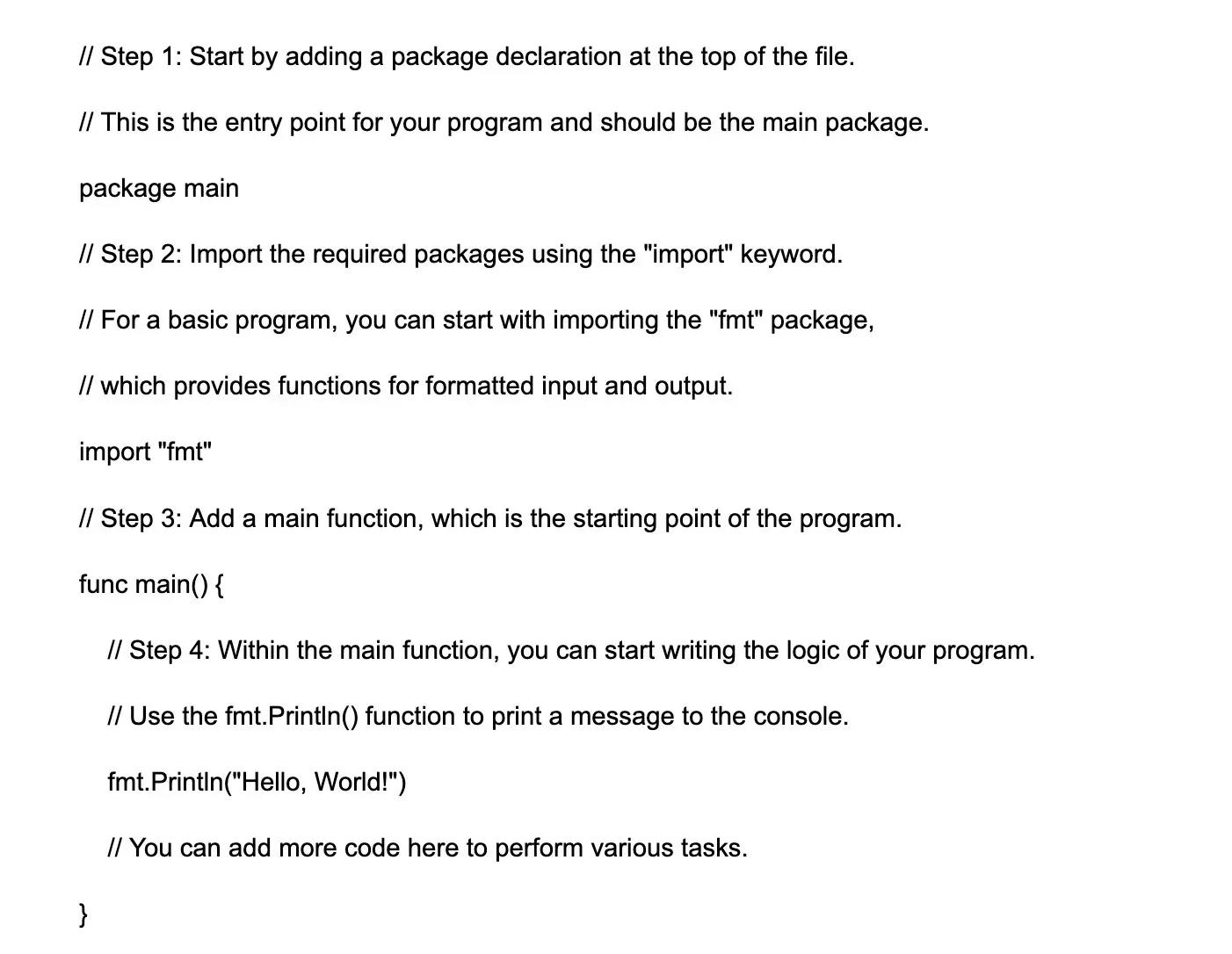
In this example:
- We start with the package declaration package main, indicating that this is the main package of the program.
- We import the "fmt" package with import "fmt". This package is essential for basic input and output operations.
- We define the main function using func main() { }, which serves as the entry point of the program. All executable Go programs must have a main function.
- Inside the main function, we use fmt.Println("Hello, World!") to print the "Hello, World!" message to the console. We can add more code within the main function to perform additional tasks as needed.
5.
What is the string data type in Golang, and how is it represented?
In Golang, the string data type is used to represent a sequence of characters. It is declared using double quotes (" ") or backticks ( ). Strings in Golang are immutable, meaning once assigned, their values cannot be changed.
Golang represents strings as a sequence of bytes using UTF-8 encoding. This enables support for a wide range of characters from different languages. The length of a string is calculated based on the number of bytes it occupies.
String literals in Golang can also include escape sequences, such as "\n" for a newline character or "\t" for a tab character, allowing for more flexible string manipulation and formatting.
6.
How can you format the Go source code in an idiomatic way?
There are several best practices to format Go source code idiomatically. They ensure that code is more maintainable and readable.
- Use the gofmt command to automatically format Go code according to the language specification.
- Keep lines short, preferably less than 80 characters. This makes the code easier to read and review.
- Use braces (curly brackets) on a new line to define control structures.
- Use descriptive names for variables, constants, and functions in a concise and readable manner.
7.
Can you change a specific character in a string?
Yes, you can change a specific character in a string by determining its position and assigning a new value to that position.
For example, in Python you can use indexing to access individual characters in a string. The index starts at 0 for the first character, 1 for the second character, and so on. Once you have determined the position of the character you want to change, you can reassign it a new value using either slicing or concatenation.
However, it's important to note that strings are immutable, meaning you cannot change them in-place, but rather, you have to create a new string with the specific changes you want.
8.
How can you concatenate string values? What happens when concatenating strings?
Concatenating string values is simply the process of linking two or more strings together to form one longer string. To concatenate string values, you can use the "+" operator or the string interpolation feature available in some programming languages like Python, JavaScript, Java, C#, etc.
When concatenating strings, the resulting string will consist of all the characters from the original strings in the order they were concatenated. It’s important to note that string concatenation is an operation that can impact the performance of your code, especially if you are working with large strings or frequently joining strings in a loop.
9.
Give an example of an array and slice declaration.
Array declaration:
var numbers [5]int // Declaring an array named numbers with a fixed size of 5 and integer elements
Slice declaration:
var fruits []string // Declaring a slice named fruits without specifying its size
In Go, arrays have a fixed size while slices are dynamic and can grow or shrink. Arrays are declared using square brackets with a specified size, while slices are declared without specifying a size.
Slices are more commonly used in Go for their flexibility and ability to be changed during runtime.
10.
Explain the backing array of a slice value.
In Go, the backing array of a slice value is a hidden data structure that holds the elements of the slice. When you create a slice from an existing array or slice, the slice value itself only holds a pointer to the starting element of the slice in the backing array, along with the length and capacity of the slice.
This allows efficient manipulation of the slice without needing to copy the underlying data. If the slice is modified and exceeds its capacity, a new backing array may be allocated and the elements will be copied to the new array. It's important to understand the concept of the backing array to avoid unexpected behavior when working with slices in Go.
11.
Explain the Golang map type and its advantages.
Golang's map type is a powerful data structure that allows you to store key-value pairs. It is similar to dictionaries in other programming languages. The key advantage of using a map in Golang is its flexibility and efficiency.
With maps, you can easily retrieve values by using their corresponding keys, making it ideal for scenarios where quick lookups are required. Maps also allow you to add, modify, and delete key-value pairs dynamically.
Additionally, Golang's map type automatically handles resizing and hash collisions, ensuring optimal performance. Overall, the map type is a versatile and efficient data structure that simplifies working with key-value pairs.
12.
What is the recommended Golang package for basic operations on files? What other Golang packages are used to work with files?
The recommended Golang package for basic operations on files is the os package. It provides functions like Create, Open, Read, Write, and Close to create, open, read from, write to, and close files, respectively.
Apart from the os package, there are others that can be used to work with files:
- The io/ioutil package provides higher-level file I/O functions like ReadFile, WriteFile, and so on.
- The path/filepath package is used to operate on file paths.
13.
Explain the object-oriented architecture of Golang.
Go’s object-oriented architecture refers to the way in which the language supports the principles of object-oriented programming. While Go does not have traditional classes and inheritance like some other languages, it does have structures and methods that can be defined on those structures.
This provides a way to encapsulate data and behavior within a single entity. By using structs and methods, you can achieve similar benefits to object-oriented programming such as code reusability, modularity, and encapsulation.
Go promotes a composition-based approach where objects are built by combining smaller objects, rather than relying on inheritance hierarchies. This makes the code easier to manage and understand.
14.
What is a struct type? Can you change the struct definition at runtime?
A struct type is a user-defined composite data type in programming languages like Golang, C, and C++. It allows you to combine different data types (integers, floats, or strings) into a single entity.
Unlike some other data types, the struct definition cannot be changed at runtime. Once a struct type is defined, its structure and fields remain the same throughout the program's execution. If you need to modify the struct's definition, you would typically need to recompile and run the program again.
However, you can create multiple instances of a struct and modify the values of their fields at runtime, which provides flexibility and dynamic behavior.
15.
What are anonymous structs and anonymous struct fields? Give an example of such a struct declaration.
Anonymous structs in Go are structs without a specific name defined. They are used when you want to create a struct type that is only used in one place in your code. Anonymous struct fields are similar but are used to embed anonymous fields within a struct.
Here is an example of an anonymous struct declaration:
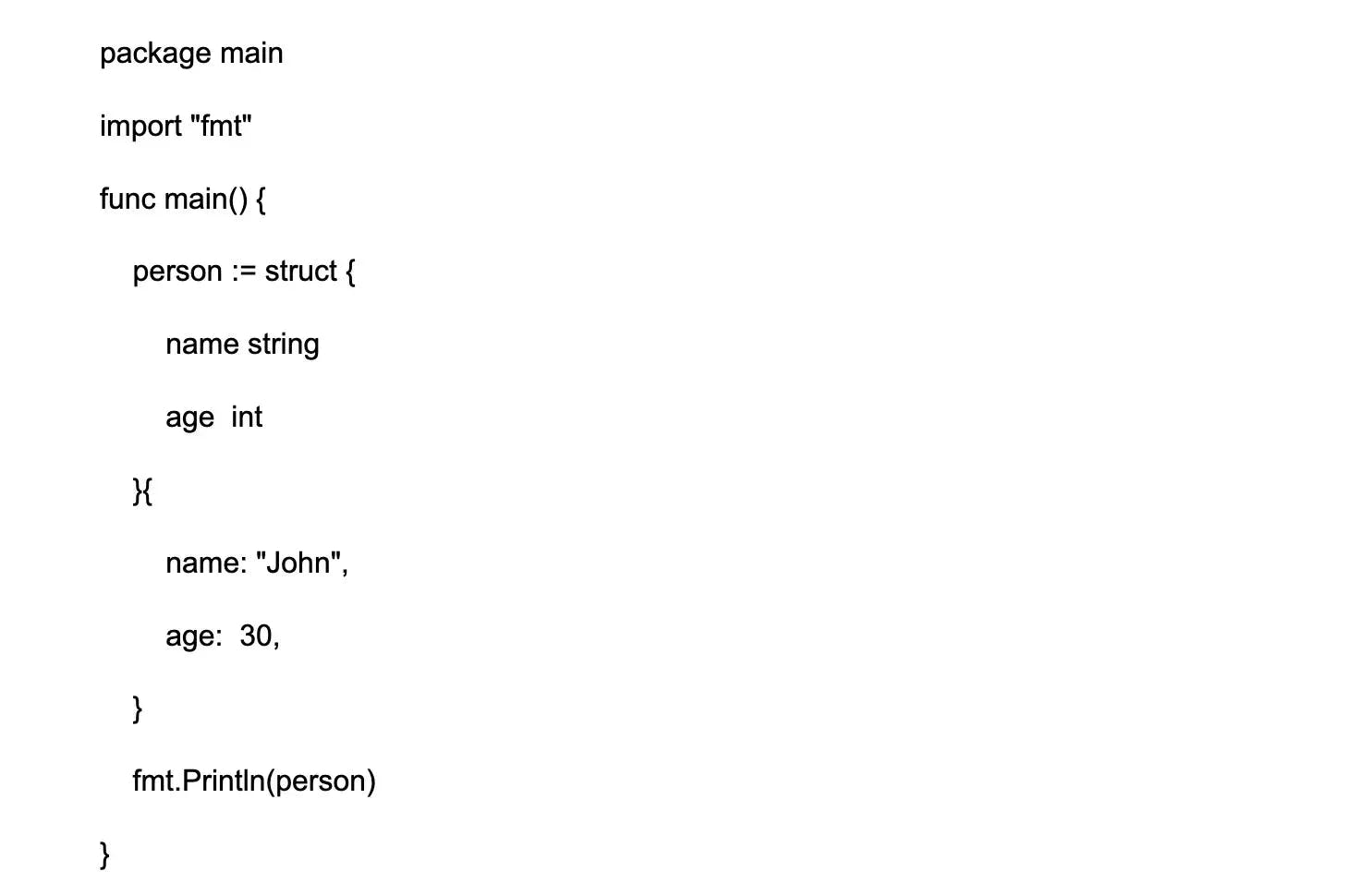
In this example, we create an anonymous struct with two fields, name and age. We then declare and initialize a variable called person using the struct type. Since the struct is anonymous, we define its fields inside the curly braces on the same line where it is declared.
16.
Explain the defer statement in Golang. Give an example of a deferred function’s call.
In Golang, the defer statement is used to postpone the execution of a function until the surrounding function completes. This is useful when you want to ensure that certain clean-up actions or resource releases are performed before exiting a function.
Here's an example of a deferred function's call:
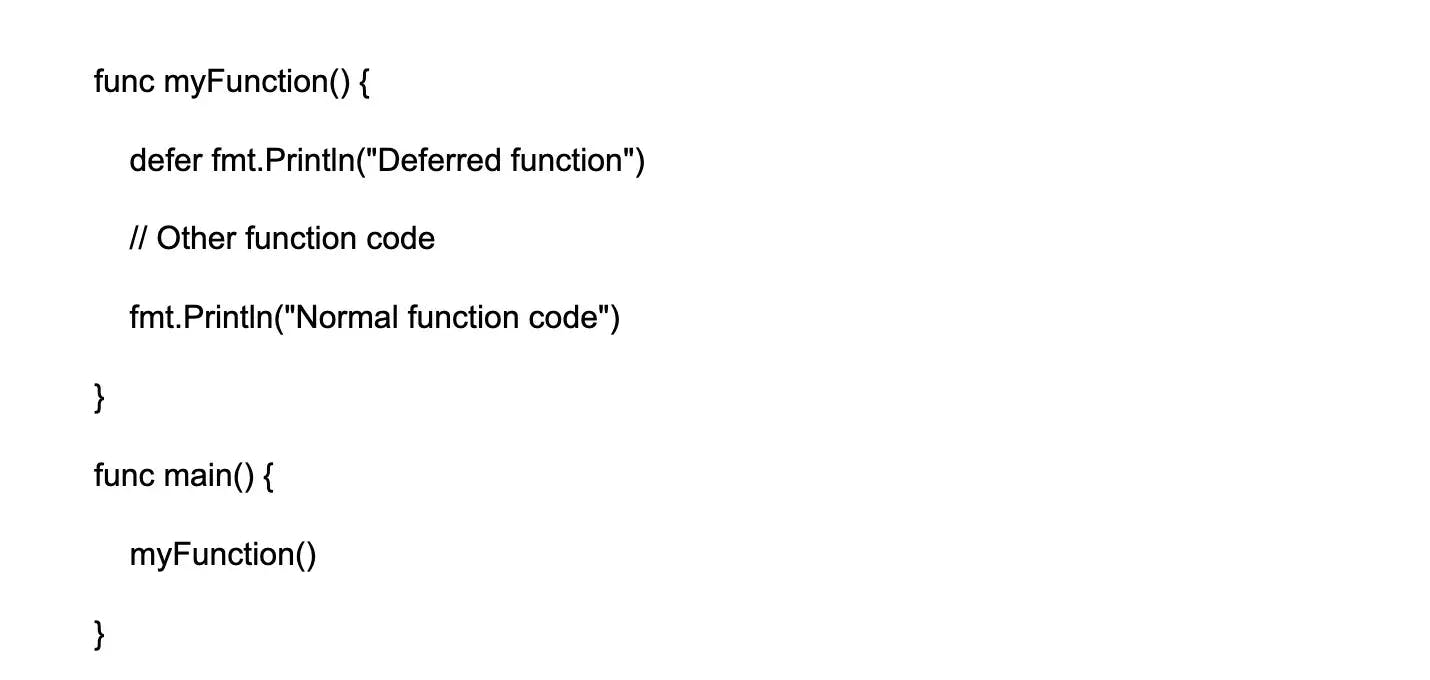
In this example, the deferred function fmt.Println("Deferred function") will be called just before myFunction() completes, regardless of whether it finishes normally or exits with an error.
17.
Write a Golang program that declares a string variable, prints the address of the variable, declares another int variable, and a pointer to it.
Here’s an example:
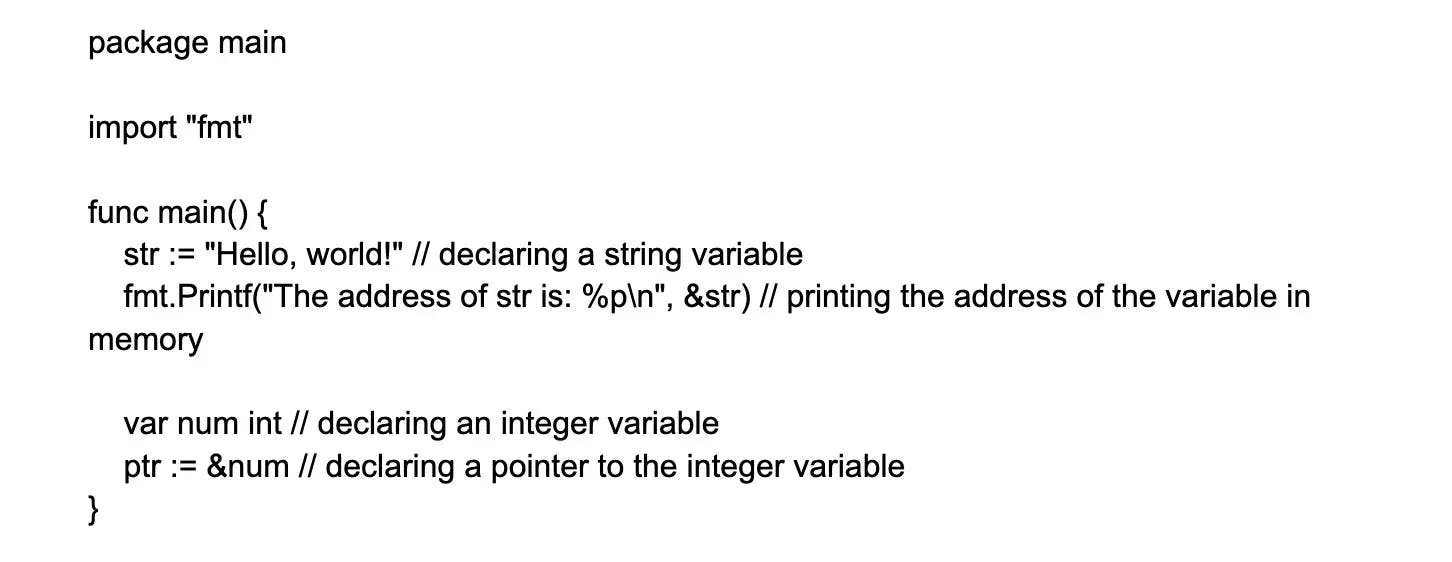
In this program, we first declare a string variable named str and initialize it to the value "Hello, world!". We then use the fmt.Printf function to print the address of str using the %p format specifier. Next, we declare an integer variable called num, and then declare a pointer named ptr to that integer variable using the & operator.
18.
What are the advantages of passing pointers to functions?
There are several advantages of passing pointers to functions:
- Efficiency: You can avoid making copies of data and work directly with the original data instead. This can save memory and improve performance, especially when dealing with large data structures.
- Shared memory: Pointers allow multiple functions to access and modify the same data, facilitating data sharing and communication between functions.
- Flexibility: Pointers provide flexibility in modifying data within a function since changes made through a pointer are reflected in the original data.
- Dynamic memory allocation: Pointers can be used to allocate memory dynamically, allowing efficient management of memory resources.
19.
What are Golang methods?
Golang methods are functions associated with a specific type that allow you to define behaviors and actions for that type. Methods can be defined for both user-defined types and built-in types.
There are two types of methods in Golang:
- Value receiver methods: These operate on a copy of the value and do not modify the original value.
- Pointer receiver methods: These can modify the original value and are generally used when there is a need to modify the underlying data.
Methods in Golang are defined using the syntax func (receiverType) methodName(). They are a powerful way to organize and encapsulate behaviors within Golang code.
20.
Create a Go program that defines a named type and a method (receiver function) for that type.
To start, define a named type using the type keyword in Go. For example, you can create a named type called Person that has two fields - name and age:

Once you have defined your named type, create a method (or receiver function) for that type using the func keyword. For example, you can create a method called greet that takes a Person as its receiver and prints out a personalized greeting like this:

With this code, you can create a new Person object, such as person := Person{"John", 30}, and then call the greet method for that object using the syntax person.greet(). The output would be "Hello, my name is John and I am 30 years old".
21.
How can you ensure a Go channel never blocks while sending data to it?
You can use a buffered channel to prevent a Go channel from blocking during a send operation. You can specify the buffer size when creating the channel using the make function. For example:
ch := make(chan int, 10) // Create a buffered channel with a buffer size of 10
This allows the channel to hold up to 10 values before blocking. When the channel is full, further send operations will block until there is space in the buffer. Using a buffered channel can help prevent goroutines from blocking, which improves concurrency in Go programs.
22.
Explain why concurrency is not parallelism?
Concurrency and parallelism are often used interchangeably, but they have distinct differences. Concurrency refers to multiple tasks being executed simultaneously, while parallelism involves splitting a task into smaller sub-tasks and running them simultaneously.
The difference lies in the nature of the tasks being executed. In concurrency, multiple tasks may be executing at the same time but they may not necessarily be related to the same task. In parallelism, the focus is on breaking down a single task into smaller sub-tasks.
Concurrency is not always parallelism because it is possible for multiple tasks to be executed concurrently on a single processor without actually being parallel. In other words, parallelism is a form of concurrency, but not all concurrency is parallelism.
23.
What is a data race?
A data race occurs in multi-threaded programs when two or more threads access shared data concurrently without proper synchronization. This can lead to unpredictable and erroneous behavior as the order of execution and access to the shared data becomes non-deterministic.
Data races can result in incorrect calculations or data corruption, compromising the integrity and correctness of the program. To mitigate data races, you can use techniques like locks, mutexes, and atomic operations to enforce exclusive access to shared data.
Additionally, programming languages and tools often provide features and utilities to detect and prevent data races during development and testing.
24.
How can you detect a data race in Go code?
One way to detect a data race in Go code is to use the built-in data race detector. It can be enabled with the -race flag when building or running the program.
The detector will use a combination of lock-set and happens-before-based algorithms to report any data race that occurs during the program’s execution. It’s important to note that race-enabled binaries use 10 times the CPU and memory, so it’s impractical to enable the race detector all the time.
25.
What is a Go channel? What operations are available on the channel type?
In the context of Go, a channel is a powerful concurrency primitive that allows goroutines to communicate and synchronize their work. Channels facilitate safe communication and data sharing between goroutines, which helps in building concurrent and parallel programs.
Operations available include:
- Sending data to a channel: channelName <- data. This operation sends the specified data to the channel.
- Receiving data from a channel: data := <-channelName. This operation receives data from the channel and assigns it to a variable.
- Closing a channel: close(channelName). This operation closes the channel to indicate that no more data will be sent.
- Checking if a channel is closed: value, ok := <-channelName. This operation checks if the channel is closed by reading from it. If the channel is closed, ok will be false.
26.
How can you ensure that a goroutine in Go receives data from a channel without blocking indefinitely if there's no data available, and without terminating prematurely if the channel is still producing data?
You can achieve this by using a buffered channel with a suitable capacity. A buffered channel allows sending data to it without blocking until the channel is full, and receiving data from it without blocking until the channel is empty. This ensures goroutines can send and receive data asynchronously without risking deadlock or premature termination.
For example, you can create a buffered channel with a capacity of 10 as follows:
ch := make(chan int, 10)
Goroutines can send up to 10 values to this channel before blocking. They can also receive from it without blocking until it's empty.
27.
Write a simple Golang program that uses a goroutine and a channel.
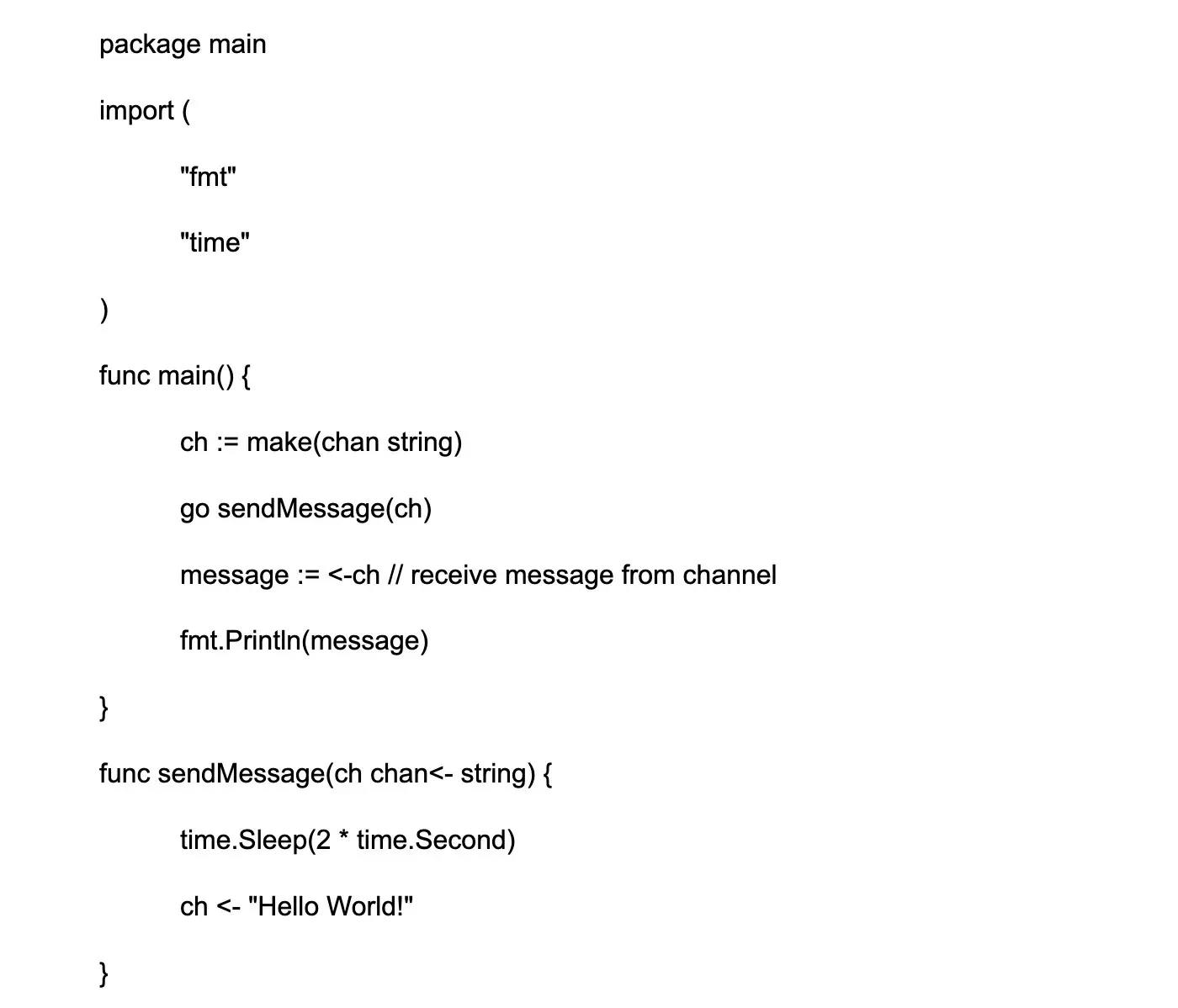
In this program, we create a channel of type string using make(). We then launch a goroutine using the go keyword and invoke sendMessage() function. Inside the sendMessage() function, we sleep for 2 seconds and then send a message over the channel. In the main routine, we wait to receive a message from the channel and print it to the console.
28.
Write a program to find the sum of all even numbers from 1 to 100.

29.
Write a program to find the largest and smallest elements in an array.
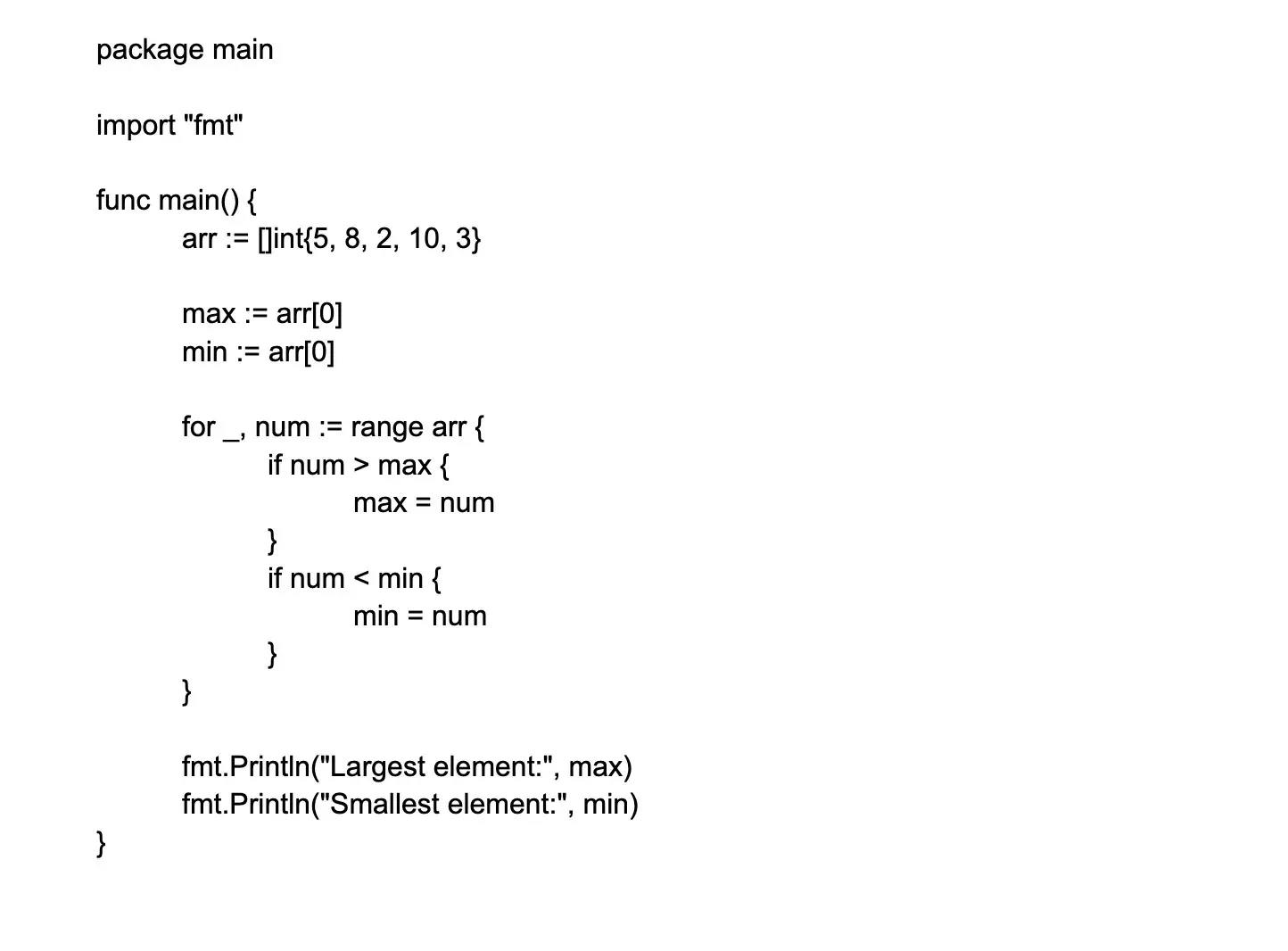
30.
Write a program to check if a number is prime.
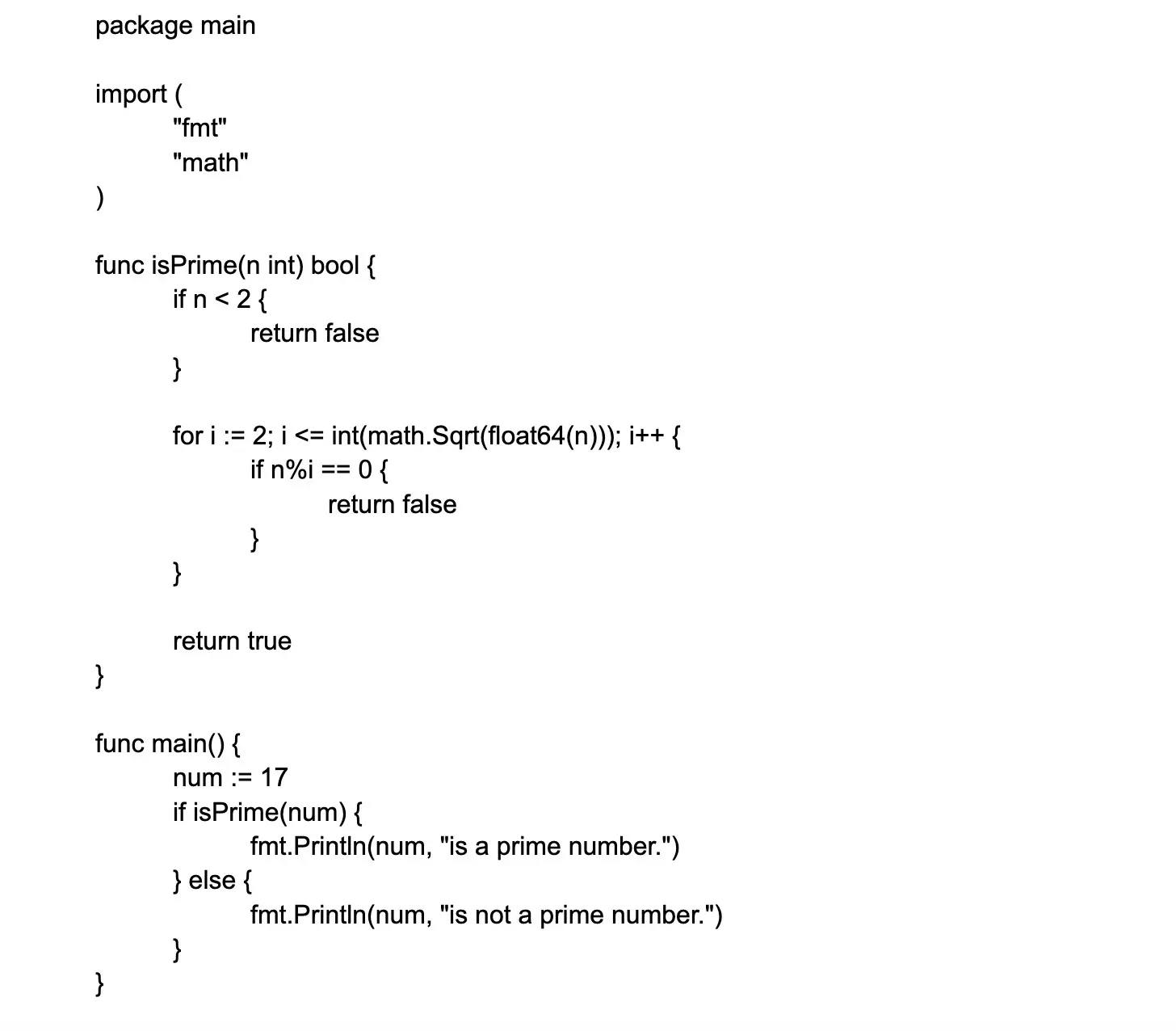
31.
Write a program to calculate the factorial of a number using recursion.
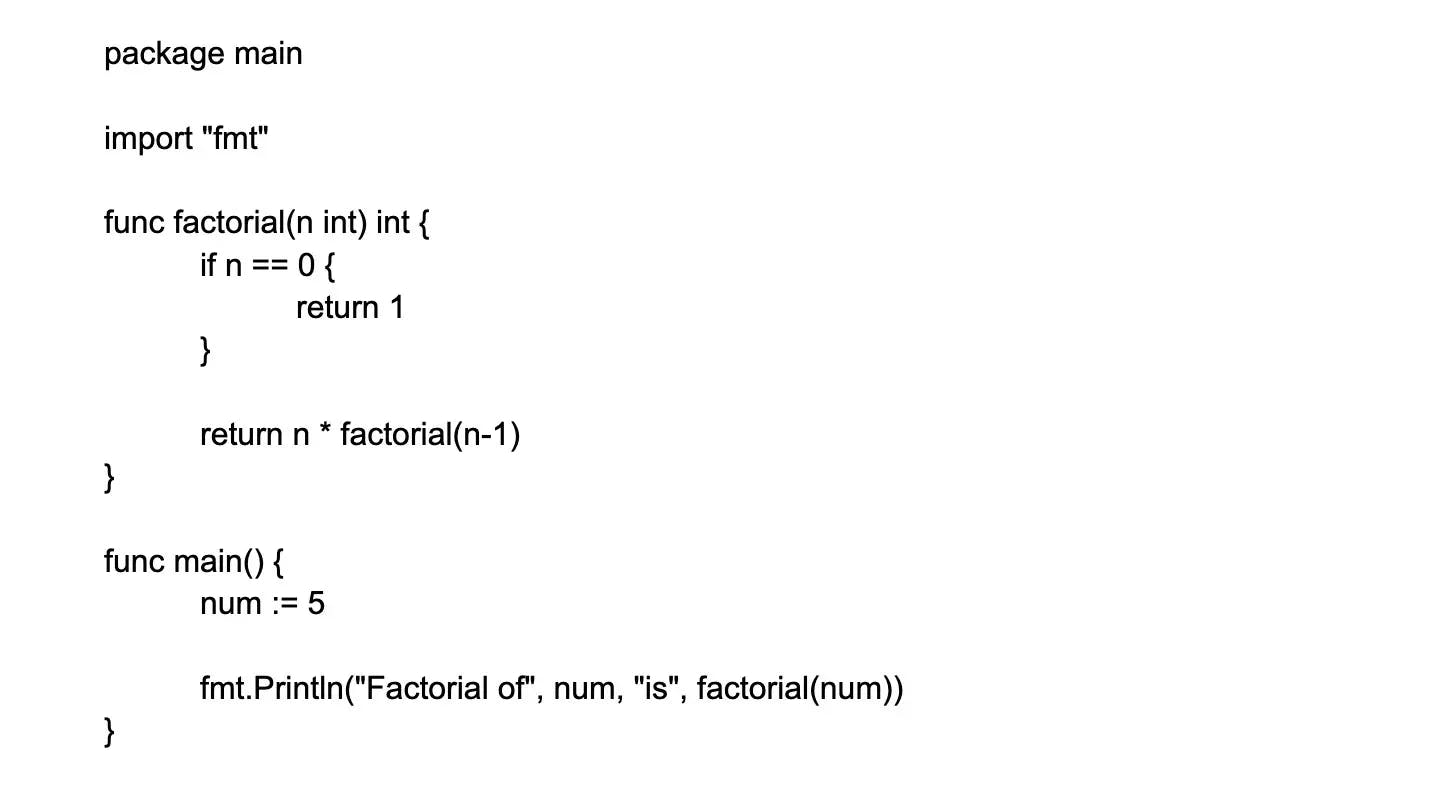
32.
Write a program to count the number of words in a given string.
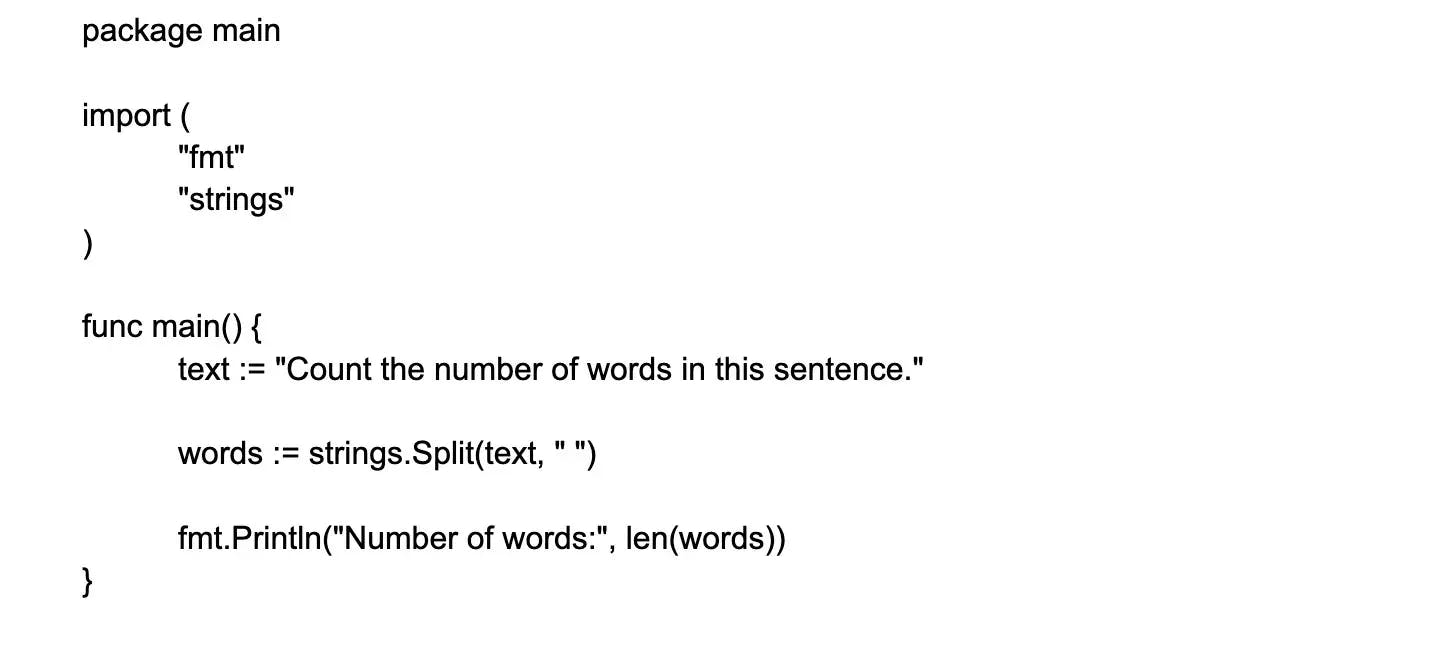
The Split method separates a string into substrings based on a specified separator, which in this case is a space character. However, it counts any sequence of characters separated by spaces as a single word, which may include punctuation marks and other non-word characters.
On the other hand, regular expressions allow us to define patterns that match only specific types of characters or substrings. By using a regular expression that matches only individual words (i.e., alphabetic characters without any separators or punctuation marks), we can get a more accurate count of the number of words in the given text
33.
Write a program to generate random numbers within a specified range.

34.
Write a program to implement a bubble sort algorithm.
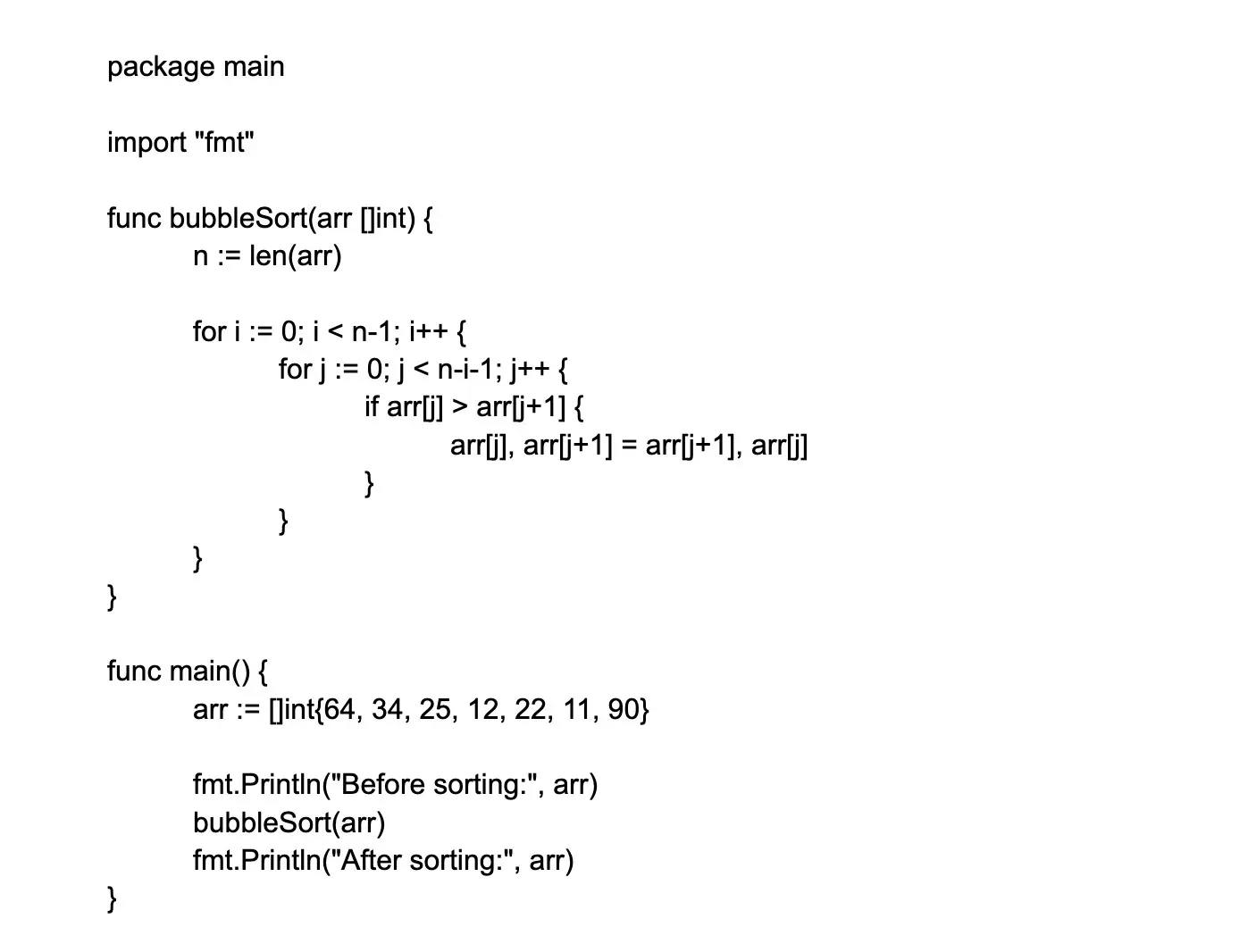
35.
Write a program to generate permutations of a given string.
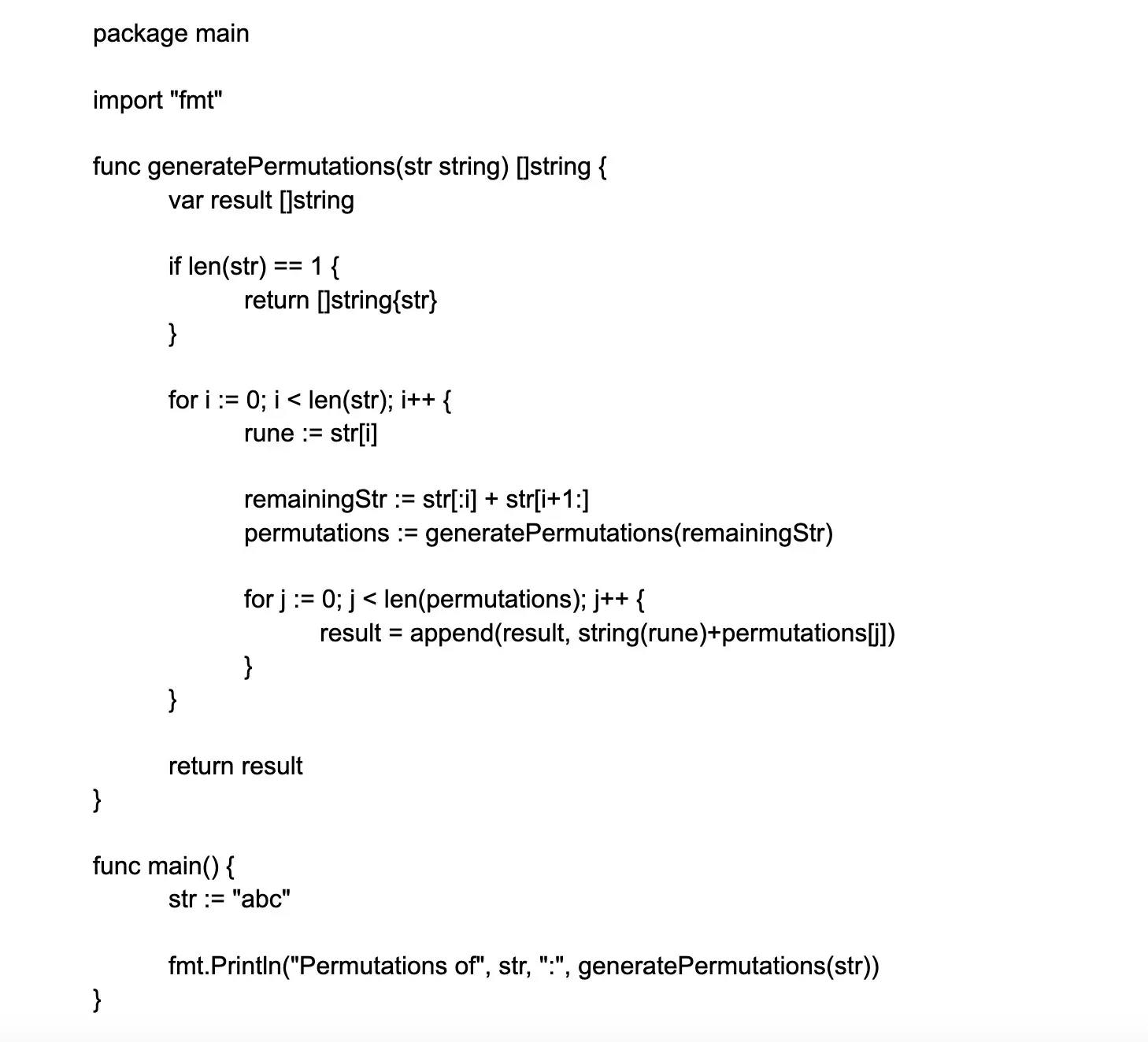
36.
Write a program to implement the Boyer-Moore string search algorithm.

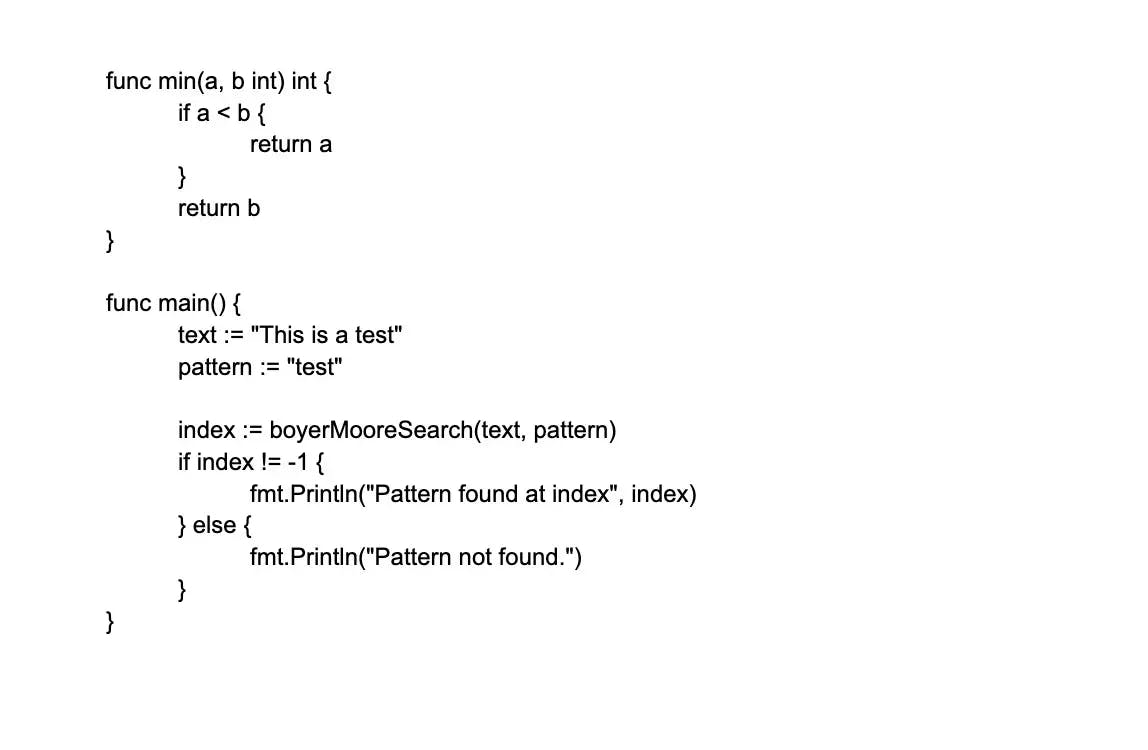
37.
Write a program to find the longest increasing subsequence in a given array.
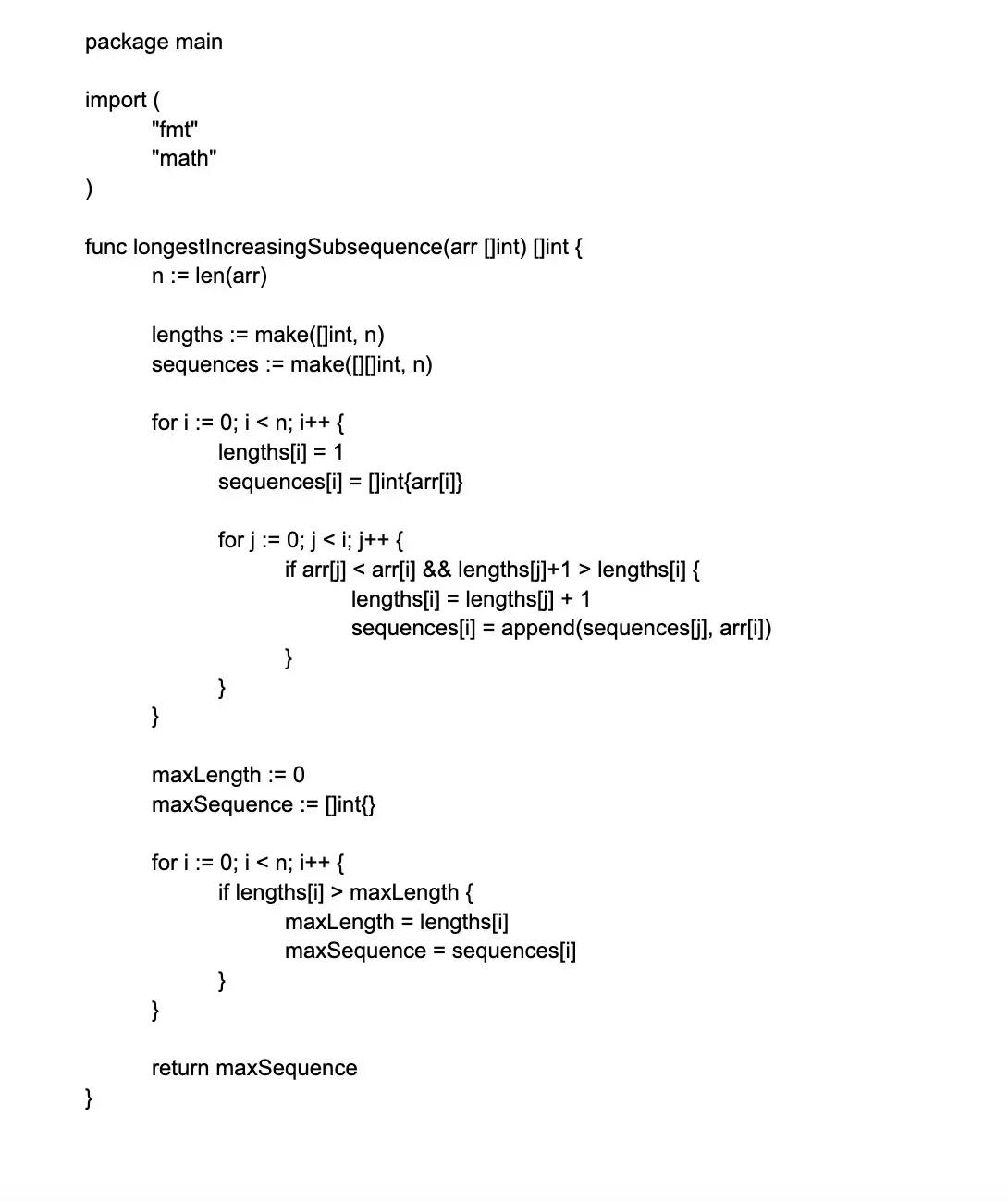

38.
Write a program to implement a binary tree and perform various operations.
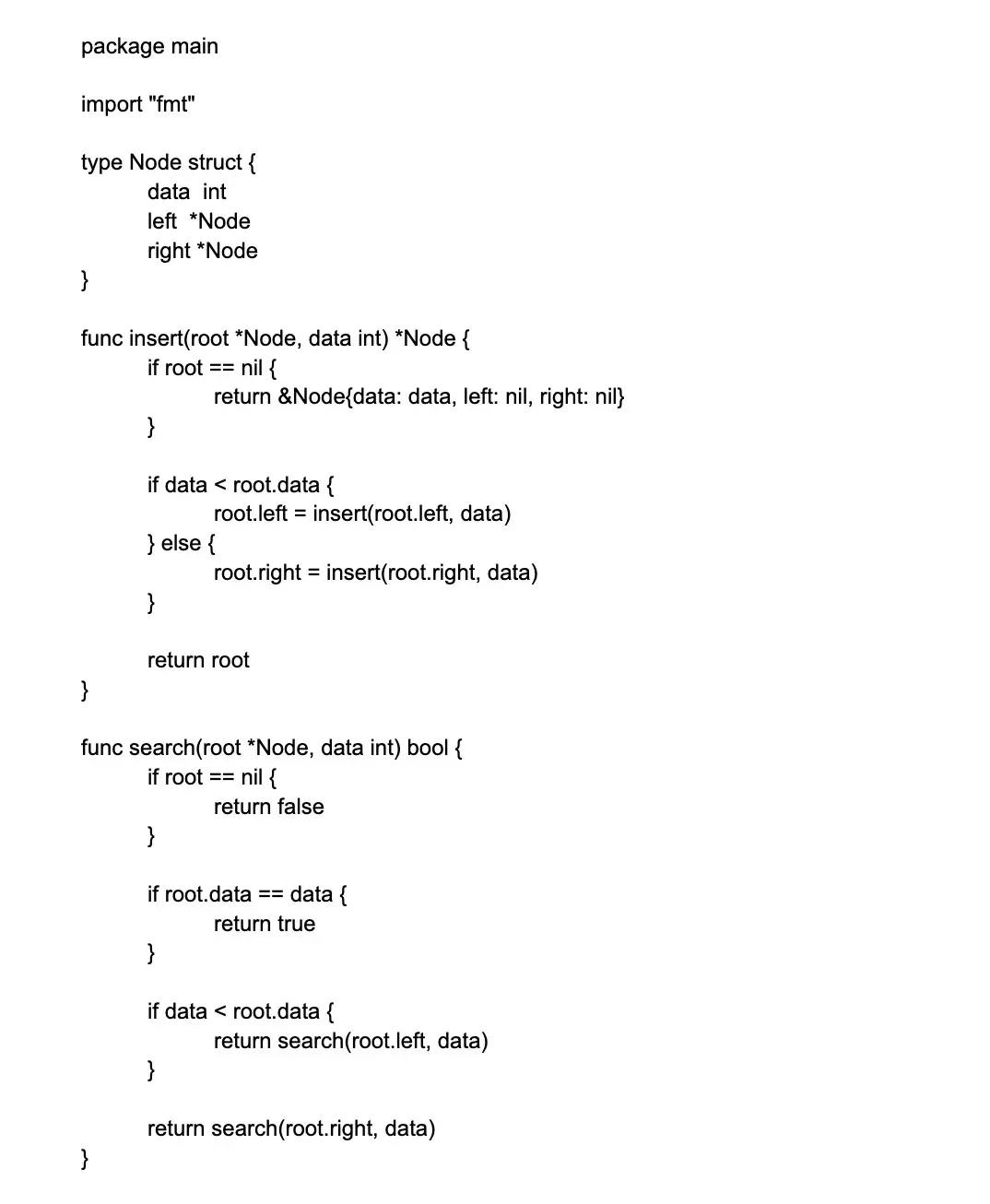
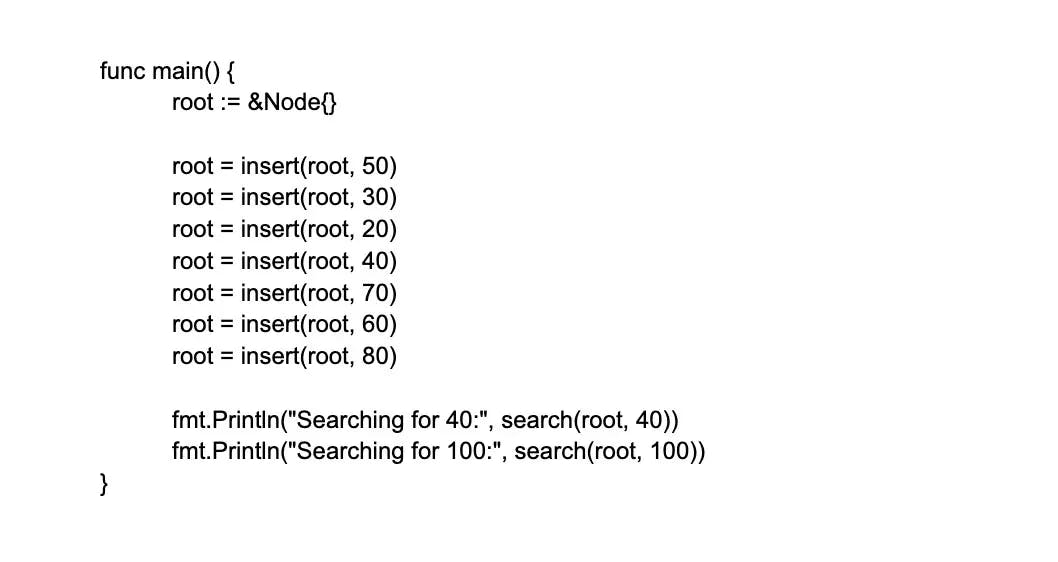
39.
Write a program to implement a stack using an array.
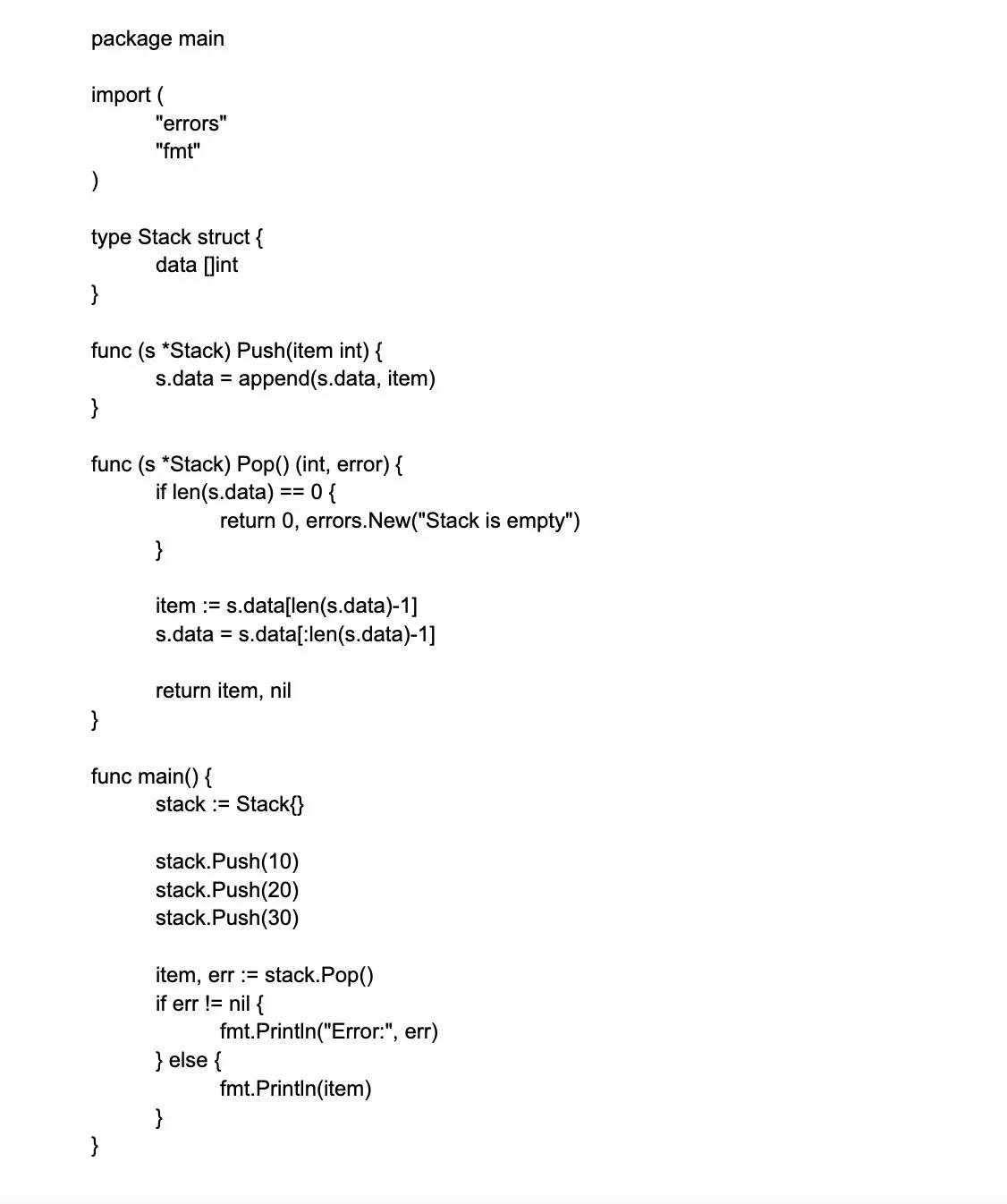
40.
Write a program to implement a queue using a linked list.
Tired of interviewing candidates to find the best developers?
Hire top vetted developers within 4 days.
Wrapping up
The list of questions provided here, especially the senior Golang developer questions, can help you solve similar queries and generate new ones. Keep in mind that an interview will not solely comprise Golang interview questions. You may be assessed on your communication skills, your past work, your ability to think on your feet, etc. This allows recruiters to determine how well you perform in difficult situations and in a team.
Turing.com is a great place to start if you're an experienced Golang developer searching for a new opportunity or if you're a recruiter looking to hire from the top 1% of Golang developers.
Hire Silicon Valley-caliber Golang developers at half the cost
Turing helps companies match with top-quality remote Golang developers from across the world in a matter of days. Scale your engineering team with pre-vetted Golang developers at the push of a button.
Hire Silicon Valley-caliber Golang developers at half the cost




